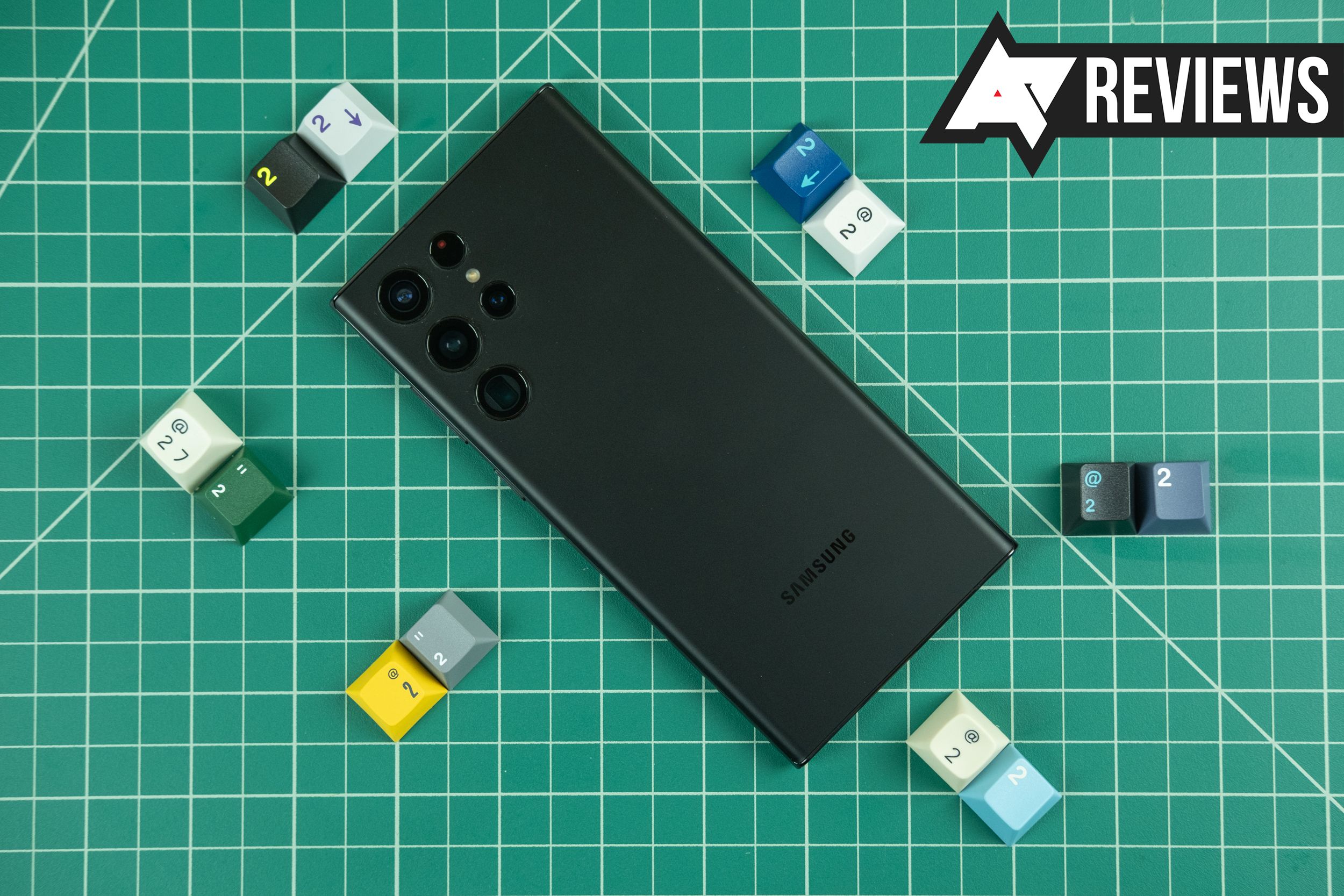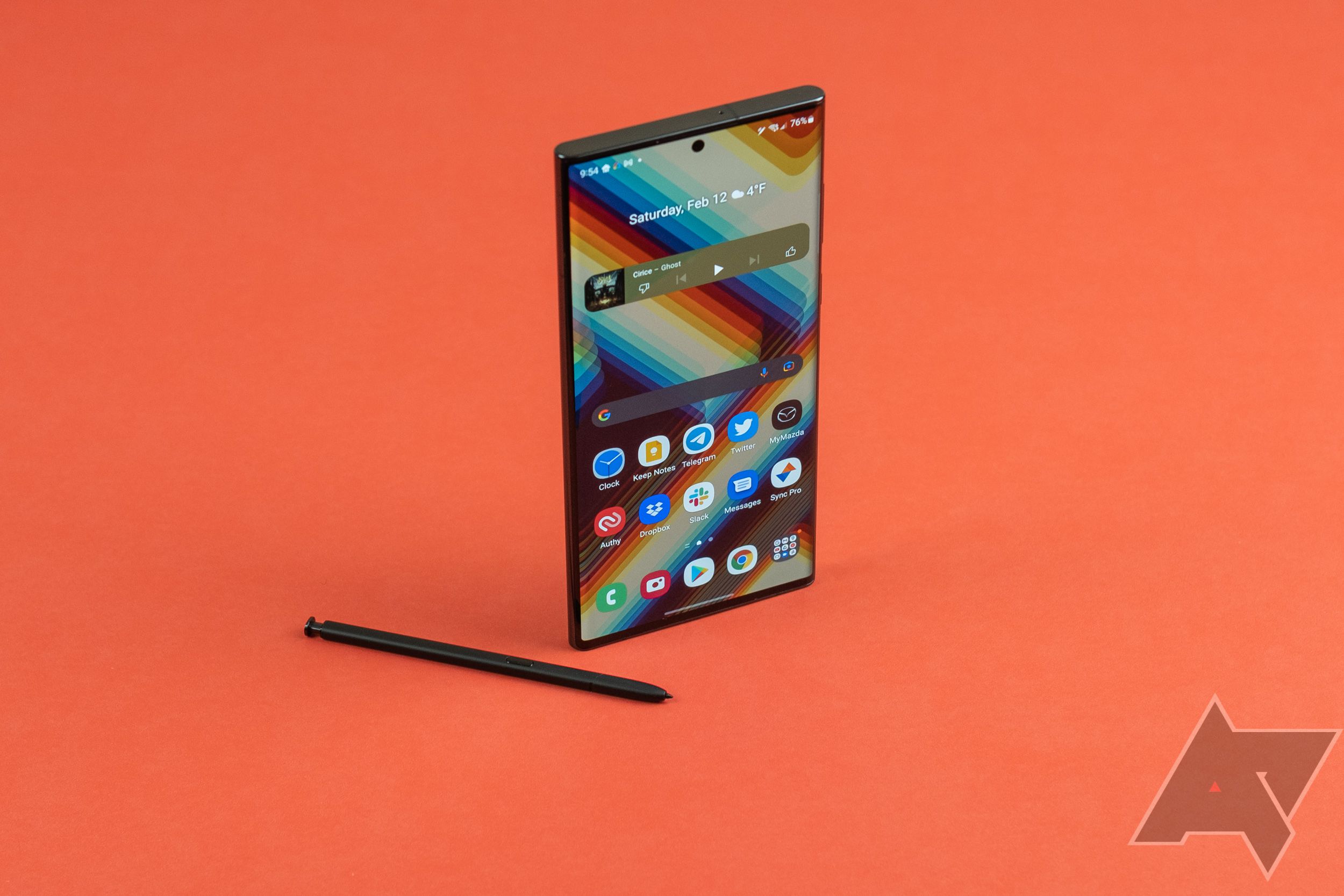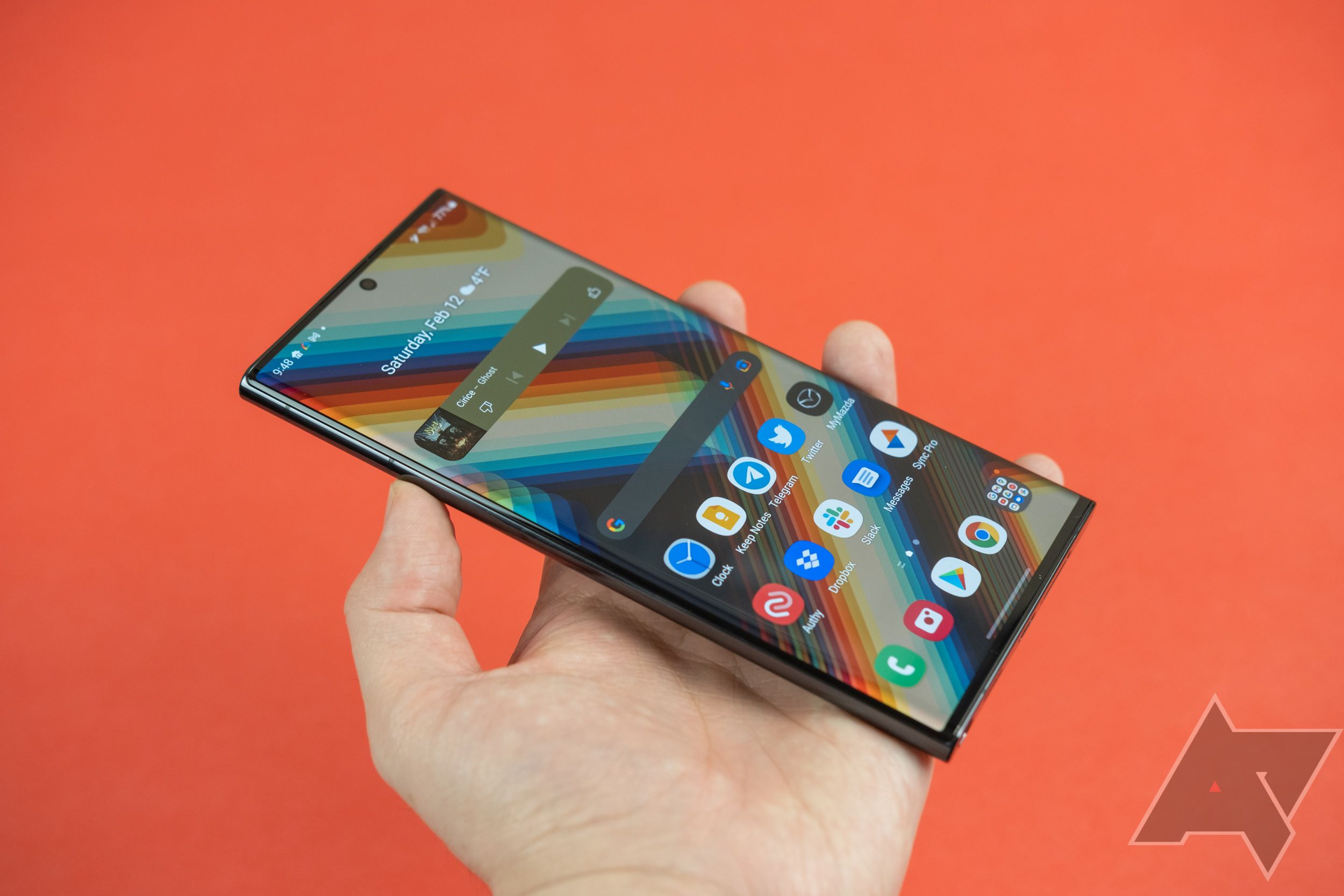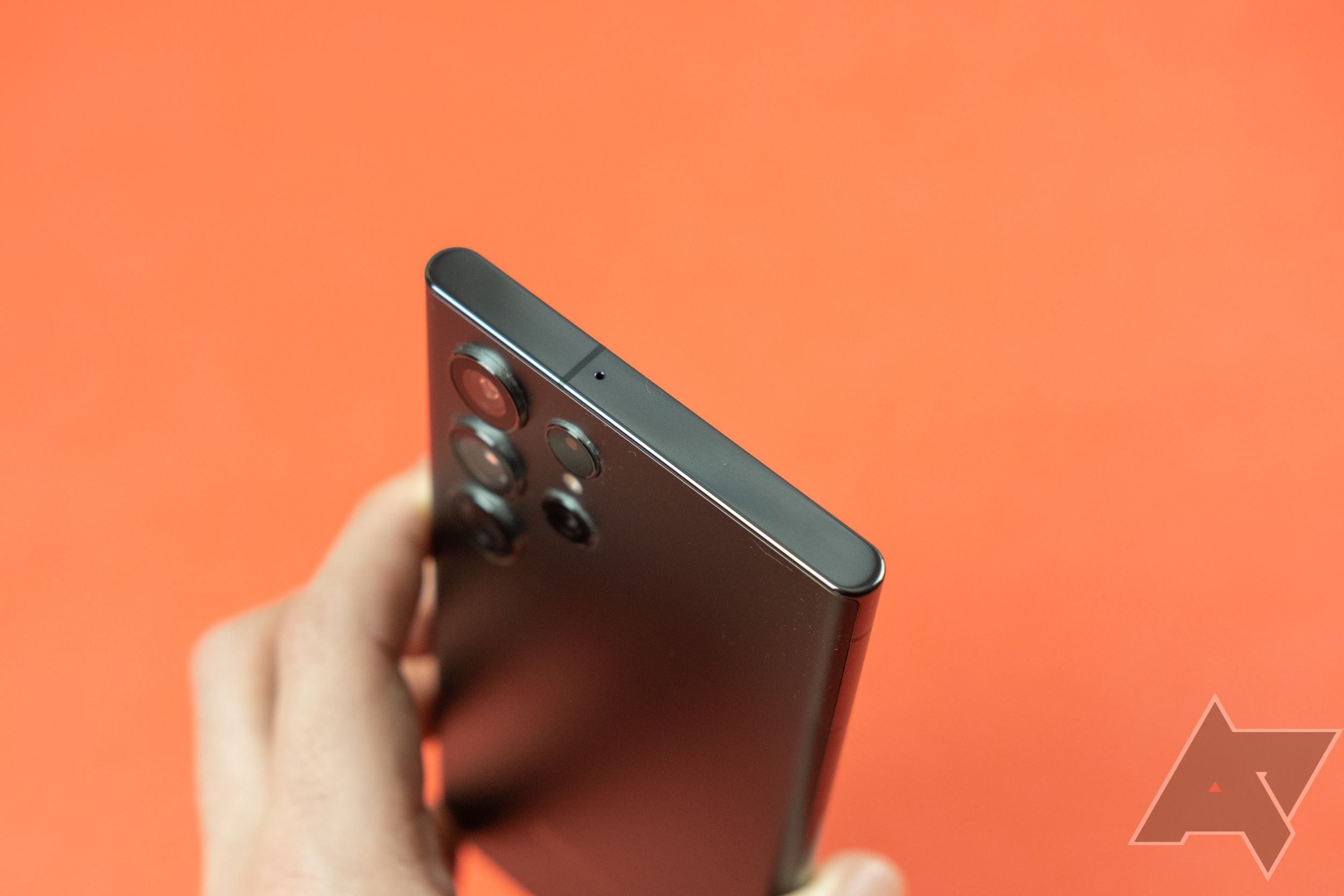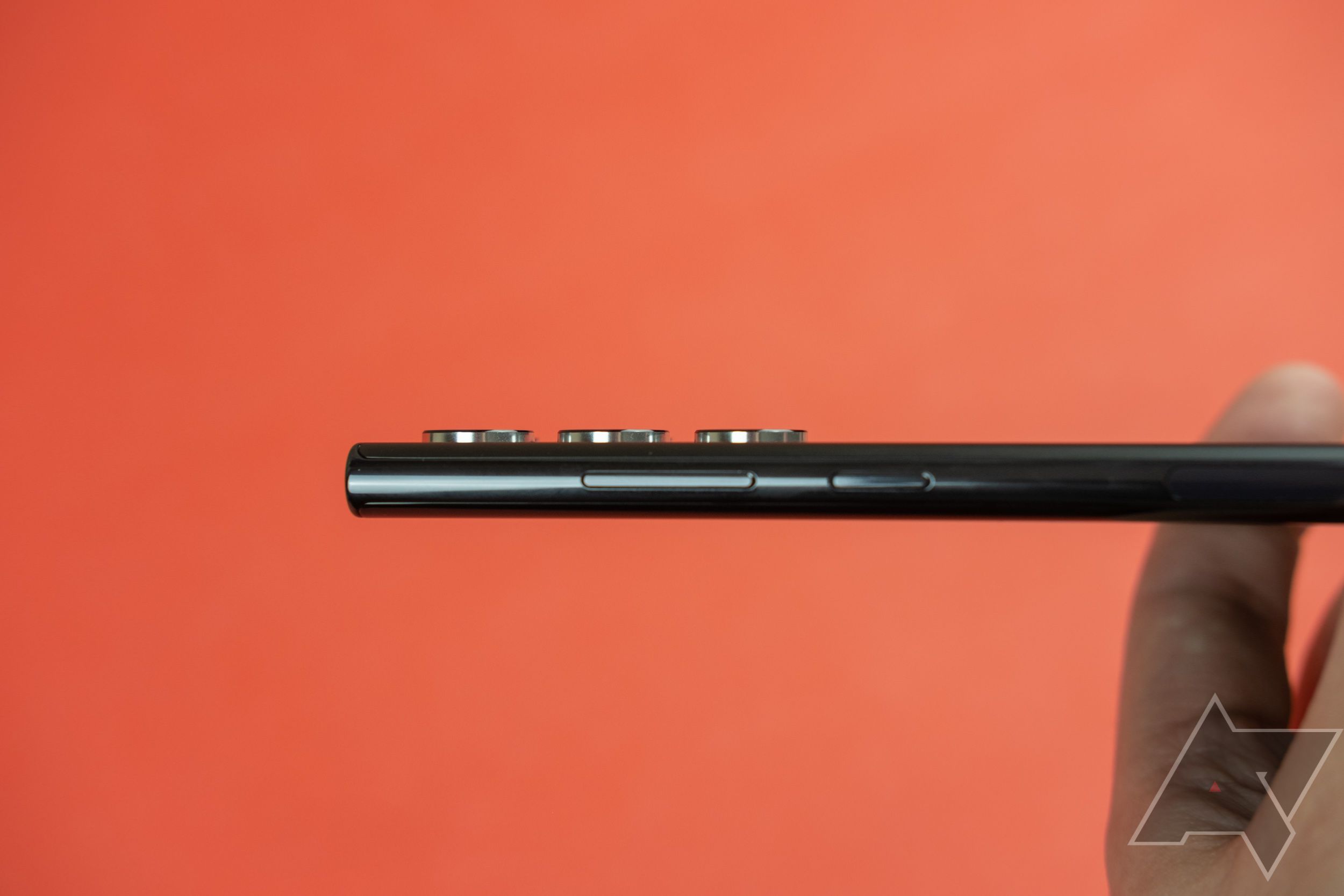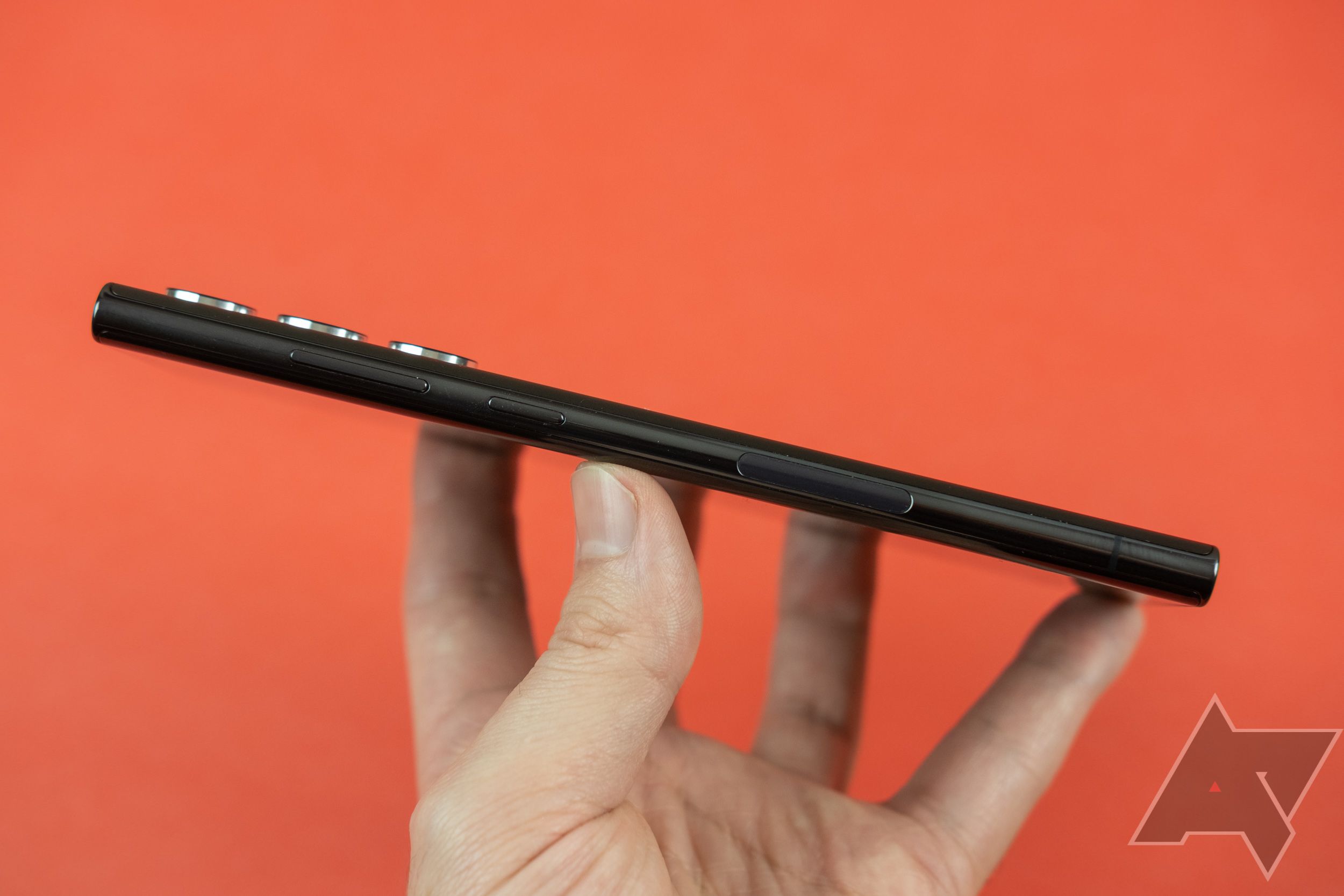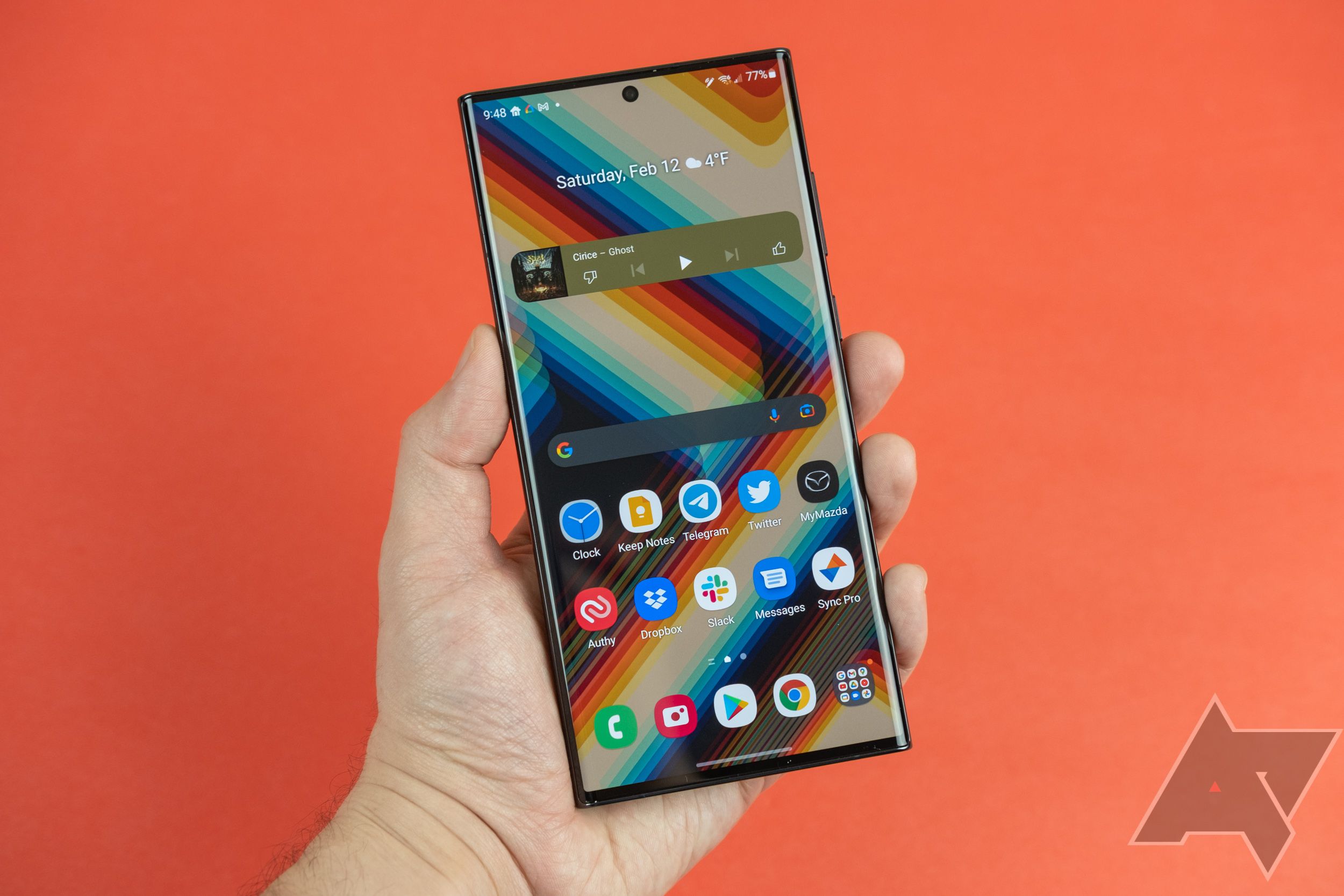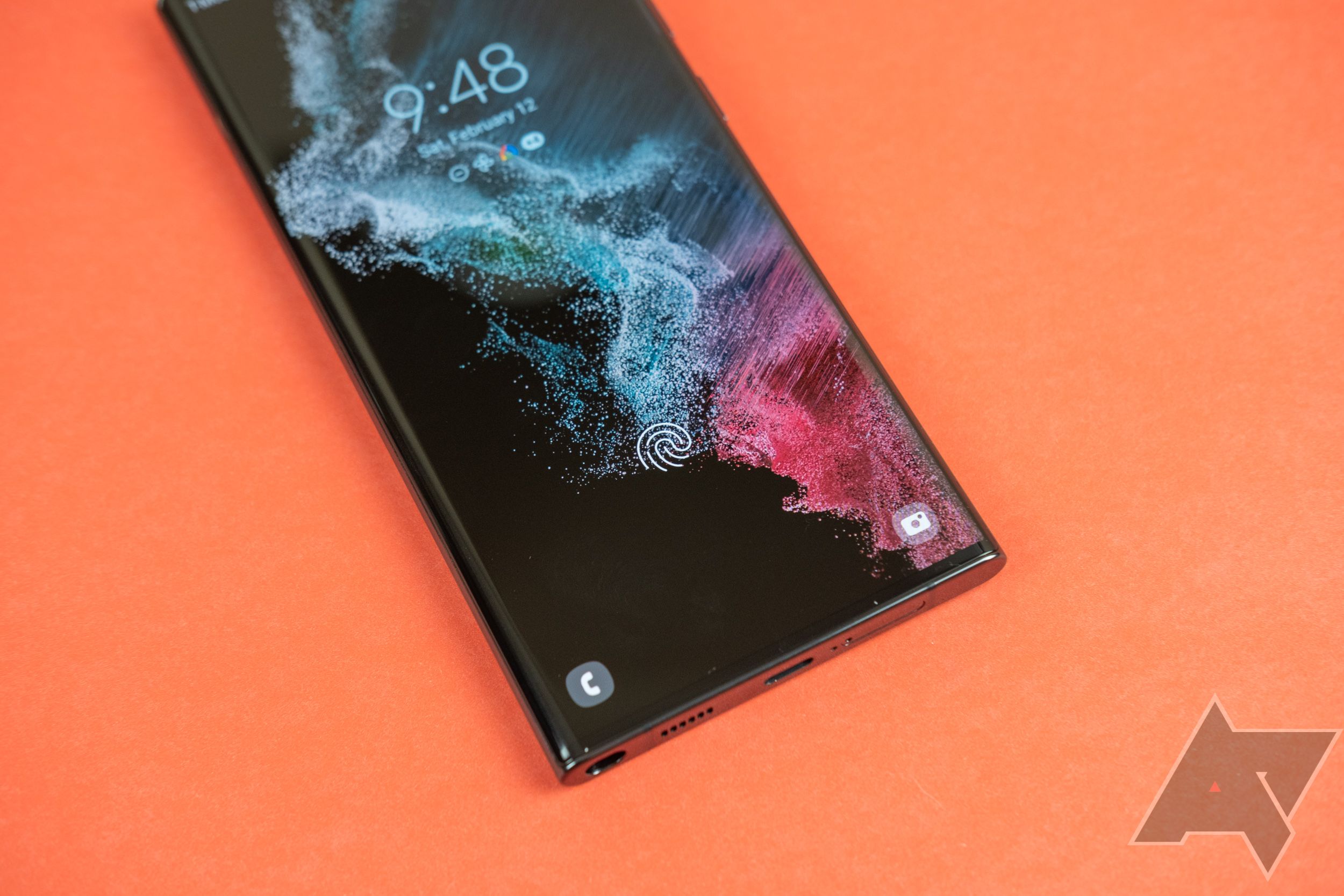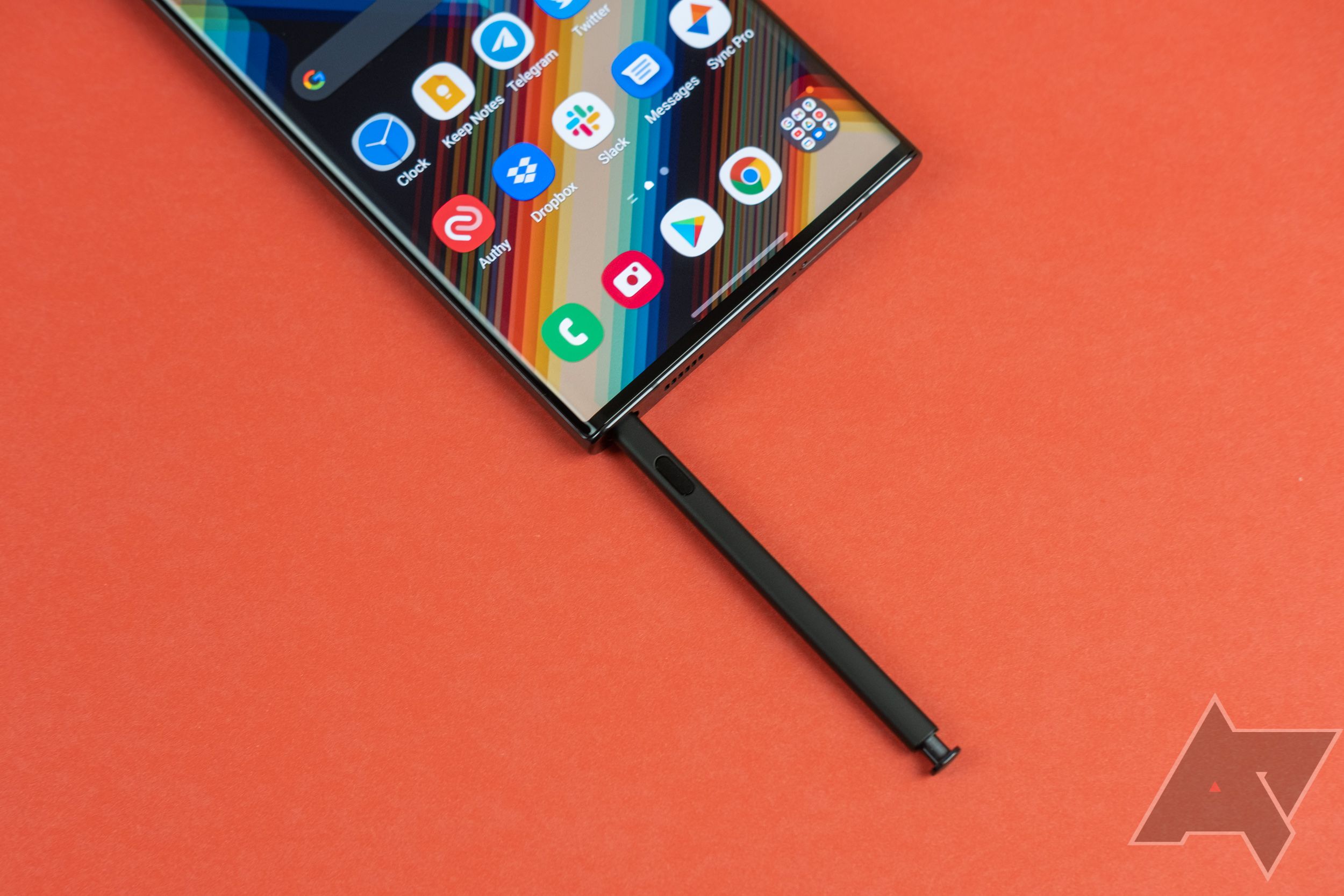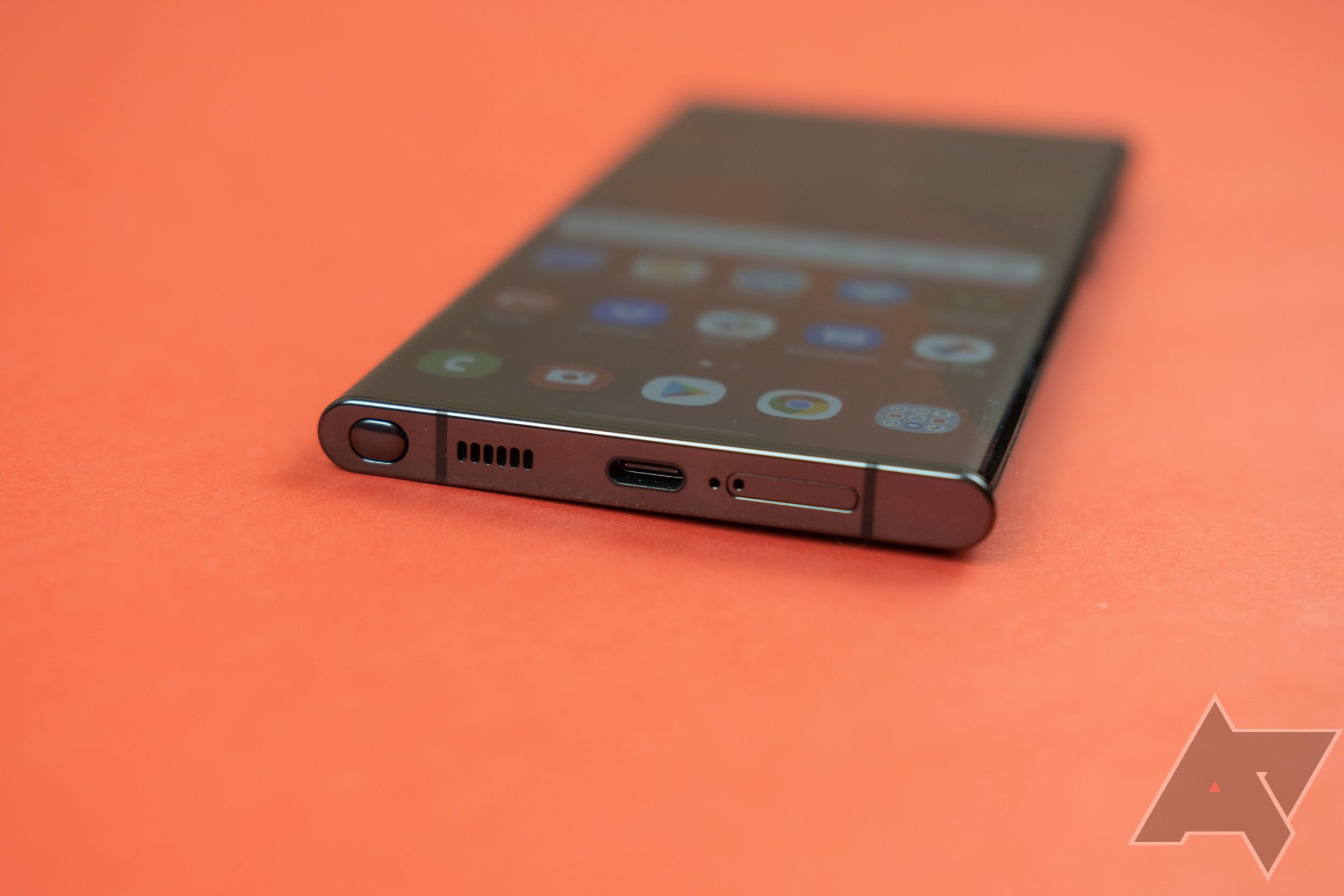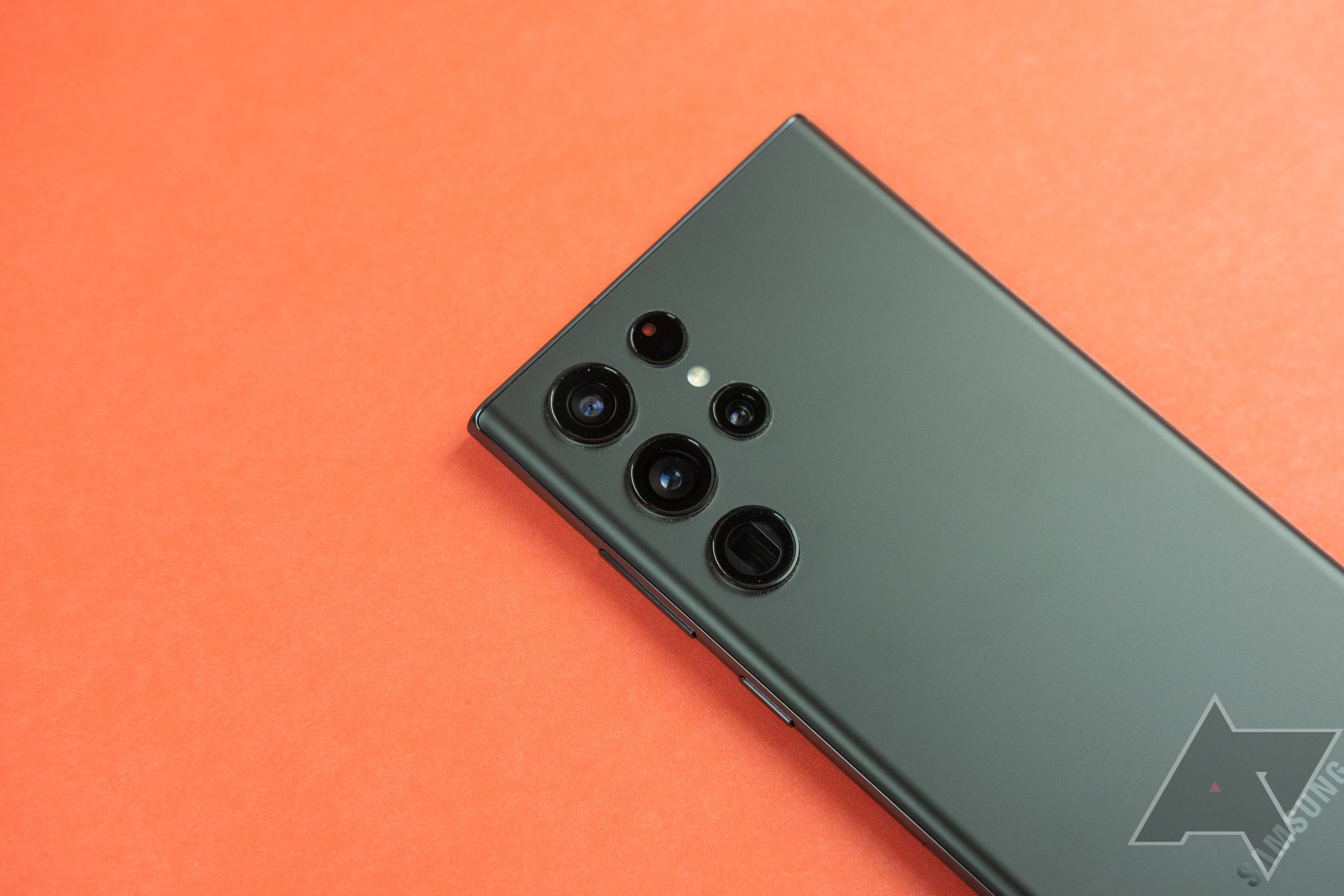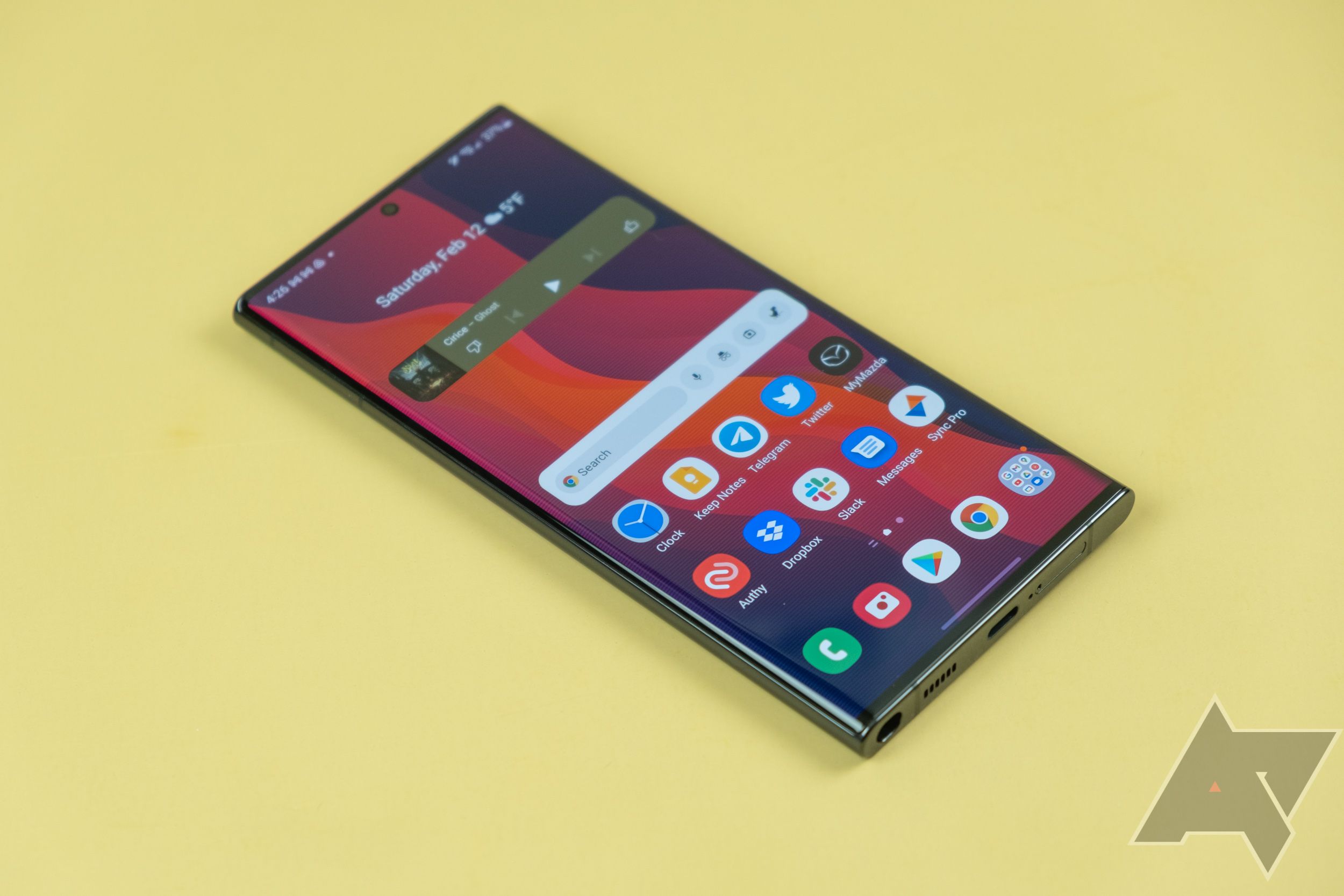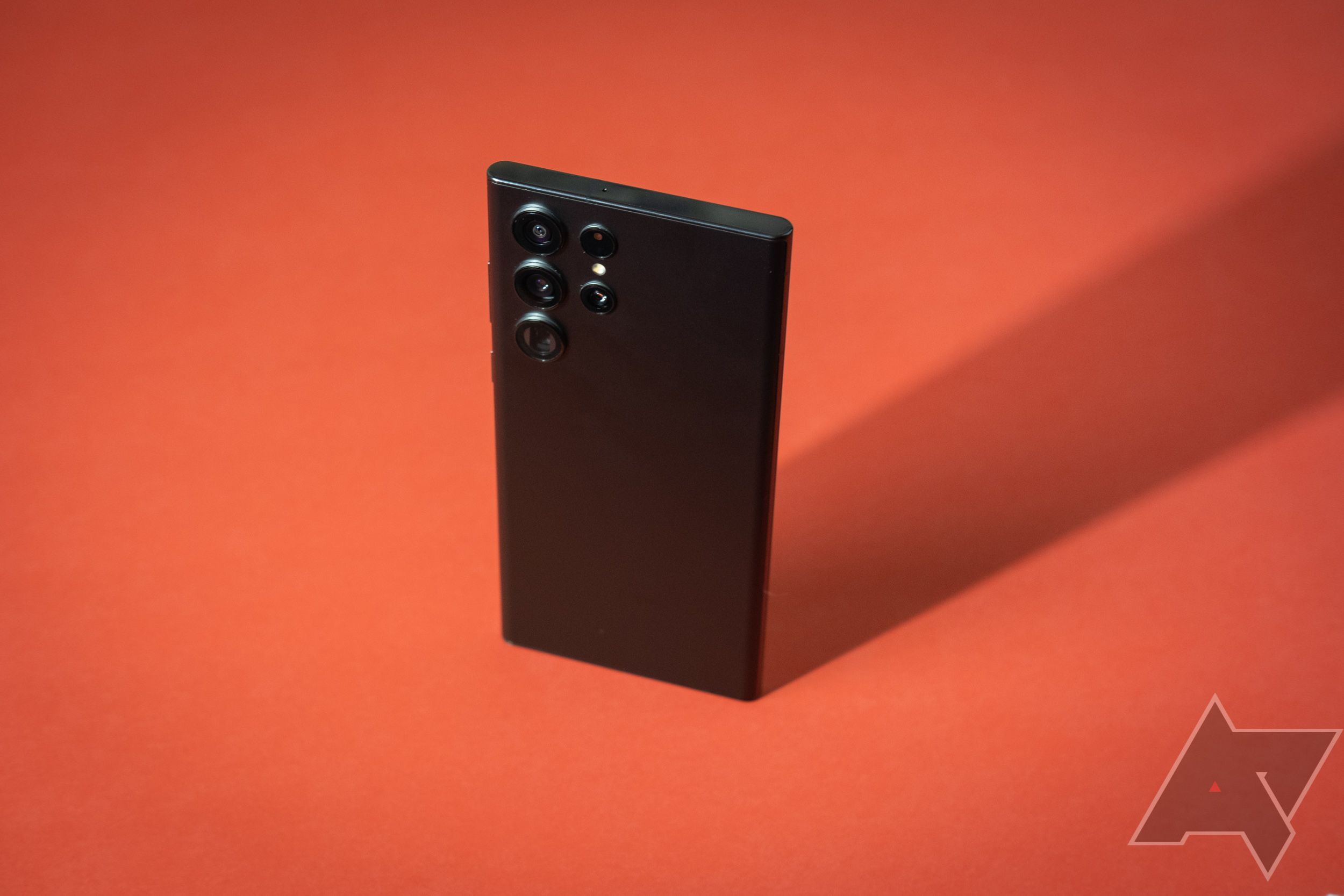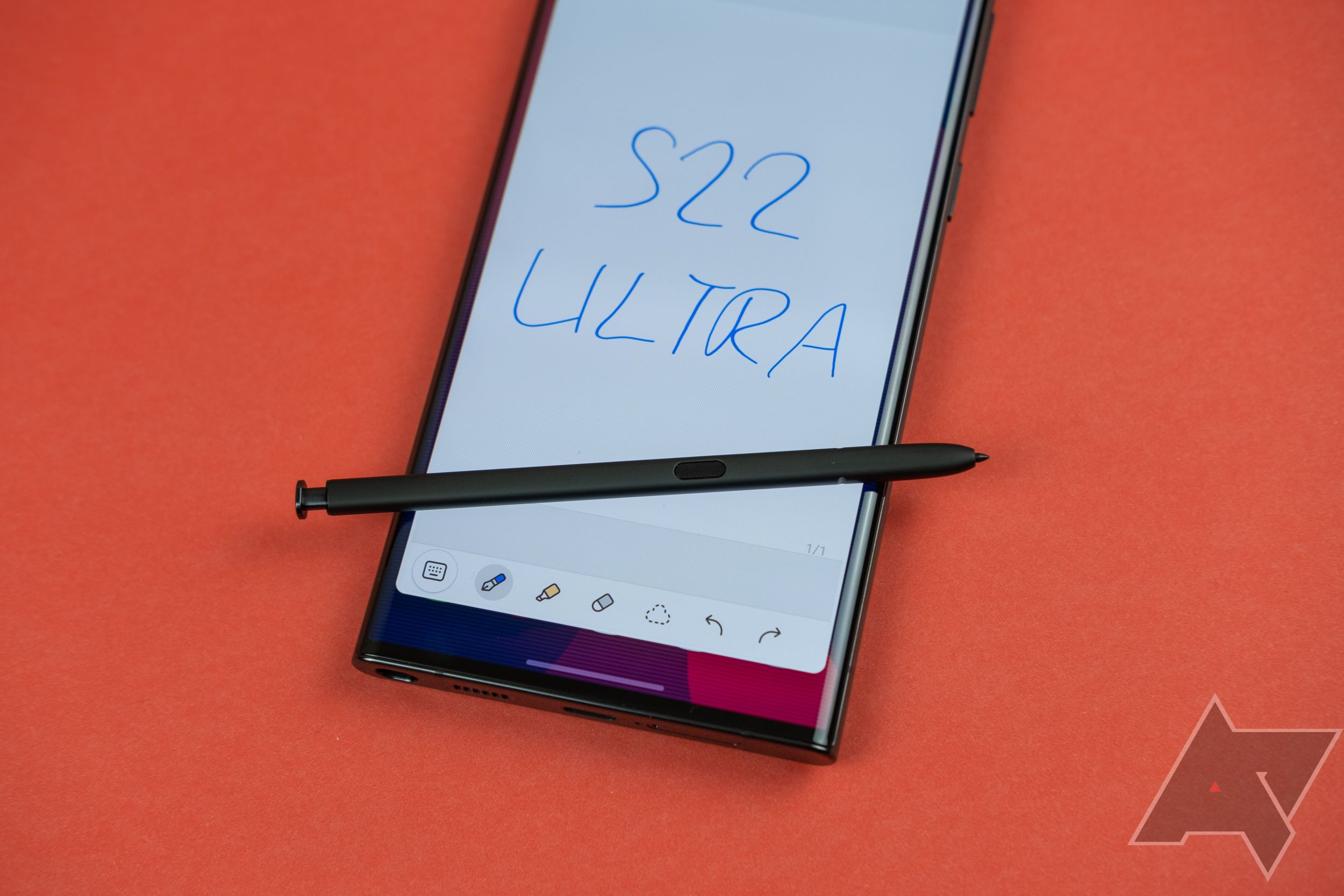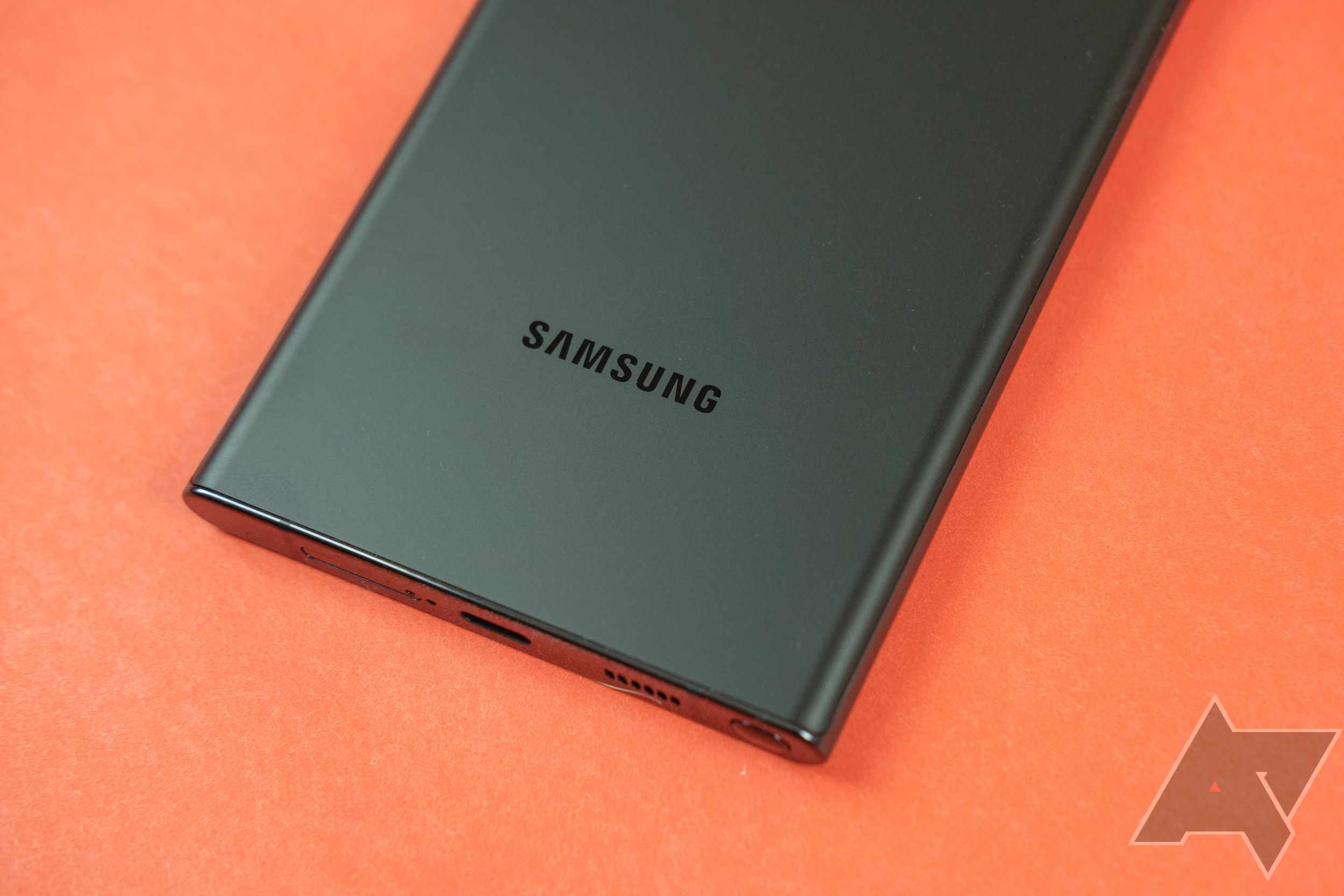Read update
- The everything phone
If I had to bet, I'd put my money on foldables being the future. Increasingly, the high-end of the market is going to shift to these devices as mobile enthusiasts warm up to the idea and prices come down. But we're not there yet—foldables still have unavoidable drawbacks that you won't have to worry about with the Galaxy S22 Ultra. This phone doesn't fold, but it does just about everything else you could ask of a flagship device in 2022.
Much has been made about the design and integrated S Pen of the S22 Ultra, which clearly pegs it as a Note phone in all but name. The name might not fit, but the model family doesn't matter—what matters is "Ultra." This phone earns the moniker with a superb display, speedy performance, a hyper-advanced camera array, and the best build quality this side of the iPhone. Oh, it's expensive to be sure, but for a certain kind of smartphone buyer, the S22 Ultra might be the only choice.
Samsung Galaxy S22 Ultra
The Samsung Galaxy S22 Ultra is the best piece of hardware running Android, but it commands a price so high that most people should look elsewhere.
- SoC: Qualcomm Snapdragon 8 Gen 1 (US); Exynos 2200 (international)
- RAM: 8GB, 12GB
- Storage: 128GB, 256GB, 512GB, 1TB
- Battery: 5,000mAh
- Ports: USB-C
- Operating System: Android 14 and One UI 6
- Front camera: 40MP, f/2.2
- Rear camera: 108MP, f/1.8 main; 12MP, f/2.2 ultrawide; 10MP, f/2.4 3x telephoto; 10MP, f/4.9 10x telephoto
- Connectivity: UWB, NFC
- Dimensions: 163.3 x 77.9 x 8.9mm
- Colors: Phantom Black, Phantom White, Green, Burgundy + Samsung.com exclusive Red and Sky Blue
- Display type: OLED, 120Hz
- Weight: 229g
- Charge speed: 45W wired, 15W wireless
- IP Rating: IP68
- Price: From $1,200
- Micro SD card support: No
- Stylus: S Pen
- Display dimensions: 6.8"
- Display resolution: 1440 x 3088
- Charge options: Wired, Wireless
- SIM support: Dual SIM (Nano SIM and eSIM)
- Cellular connectivity: 5G, mmWave, LTE
- Wi-Fi connectivity: Wi-Fi 6E
- Bluetooth: Bluetooth 5.2
- Industry-leading display quality
- Integrated S Pen stylus
- Ultra-long update support
- Powerful camera array
- Fantastic build quality
- It's a gigantic phone that almost demands two hands
- High $1,200 price tag
- Doesn't come with a charger
Design, hardware, what's in the box
Comparing the S22 Ultra to the S21 Ultra immediately reveals they are at best tangentially related. The camera modules are in the same locations, and they have roughly similar dimensions, but that's about it. For a direct comparison, we have to go back to 2020's Galaxy Note20 Ultra—that's the true ancestor of the S22 Ultra (see below). And this is fine by me. I really liked the look of the last Note phone, and this is an evolution of it. A bit thicker and more refined, but a Note all the same.
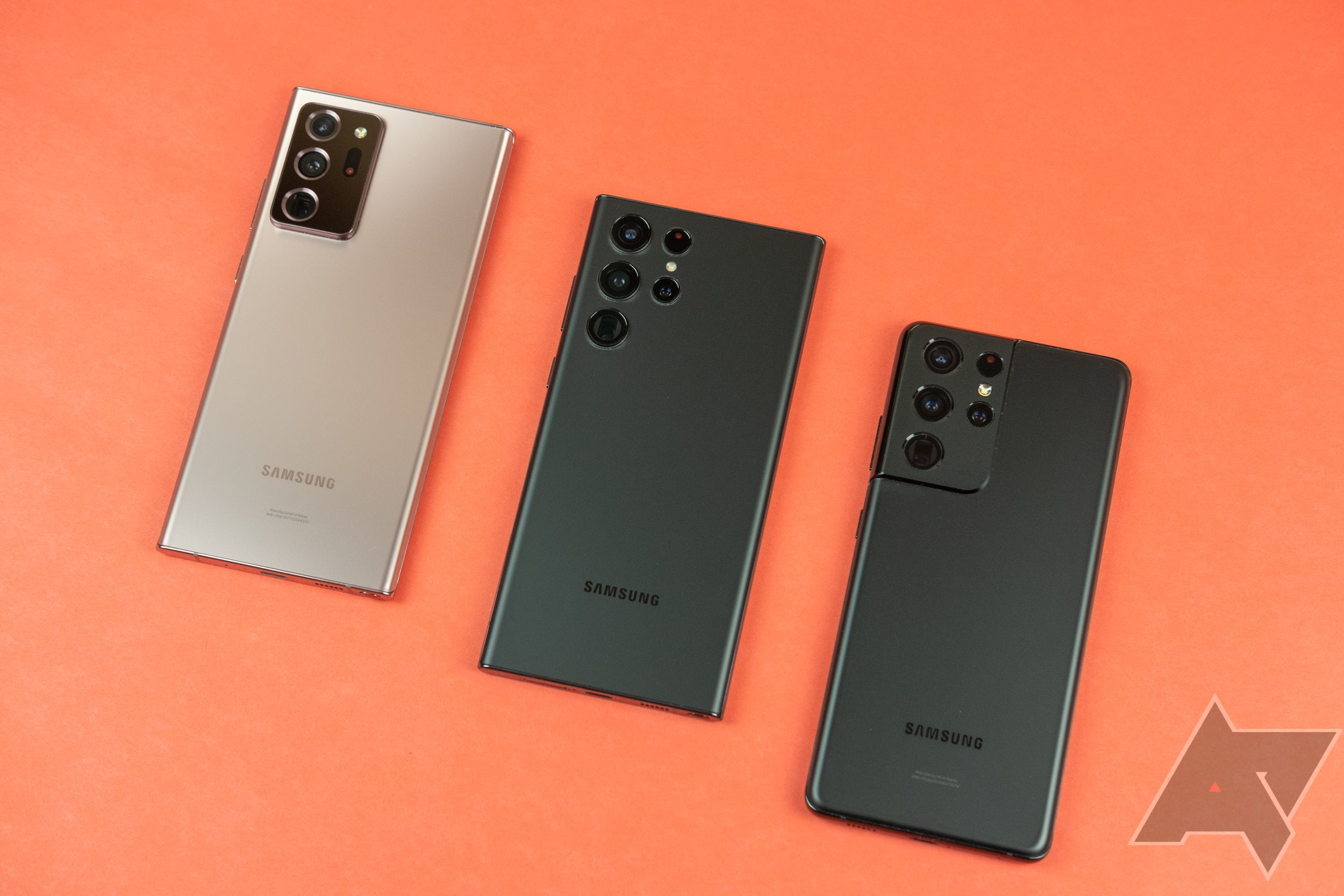
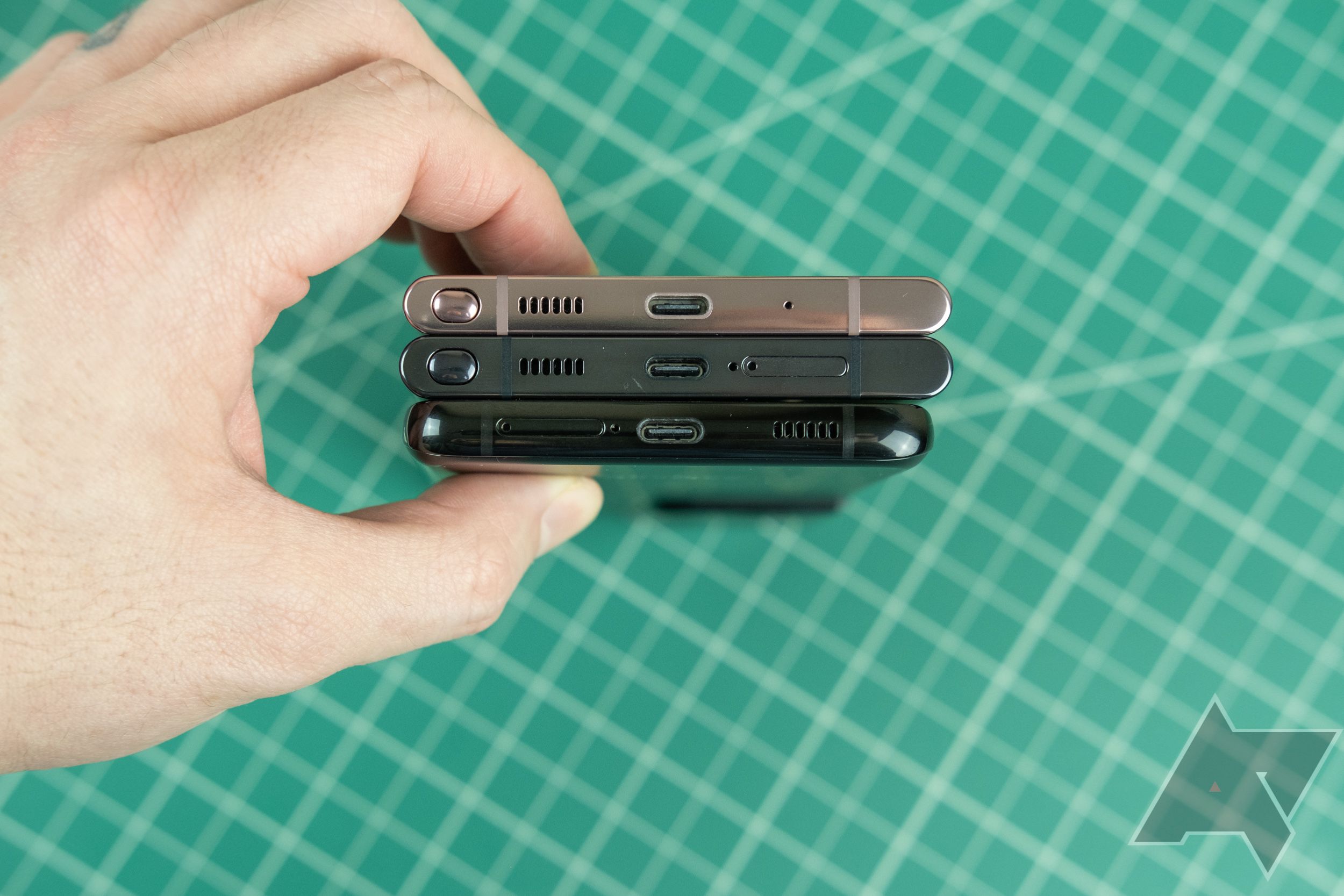
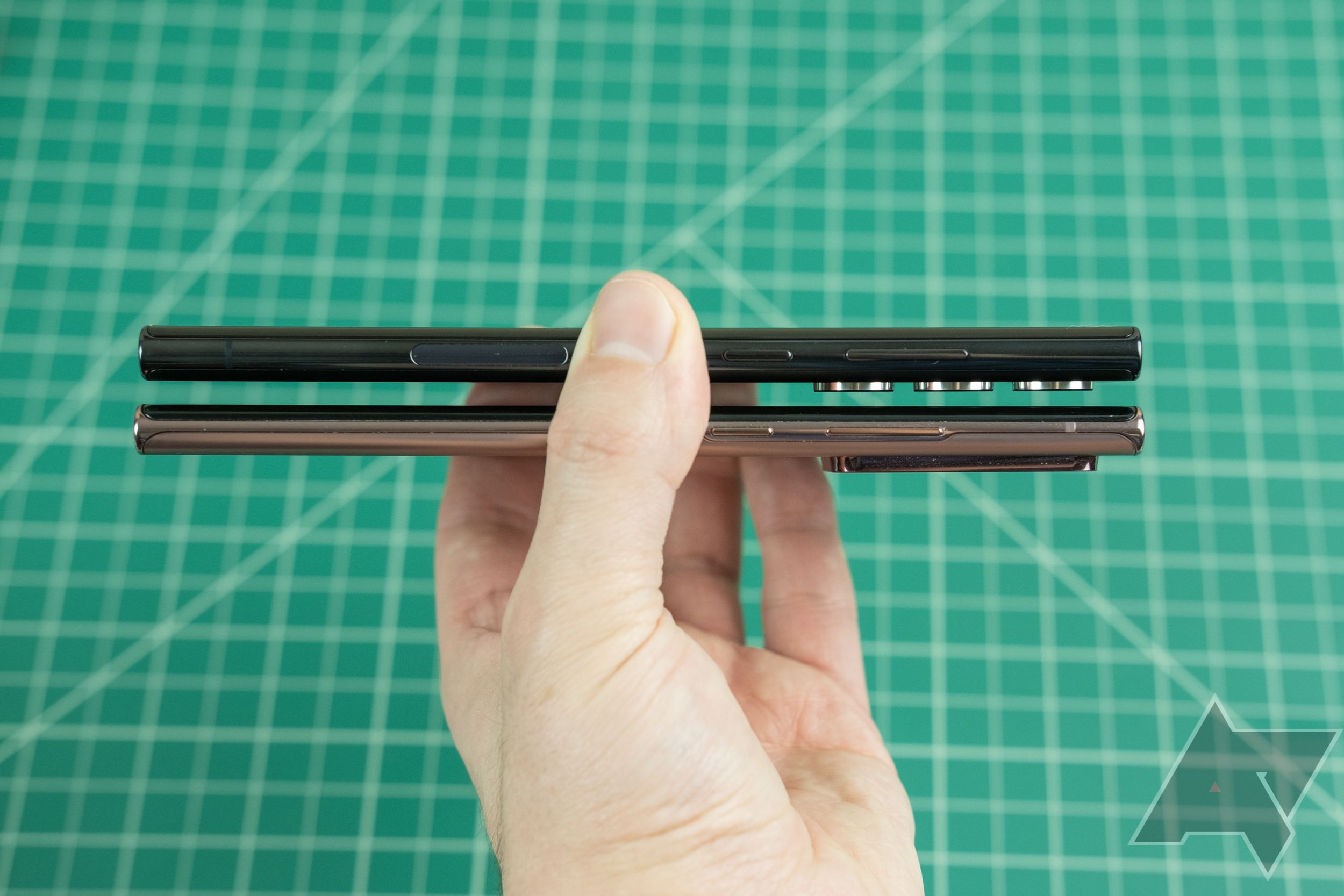
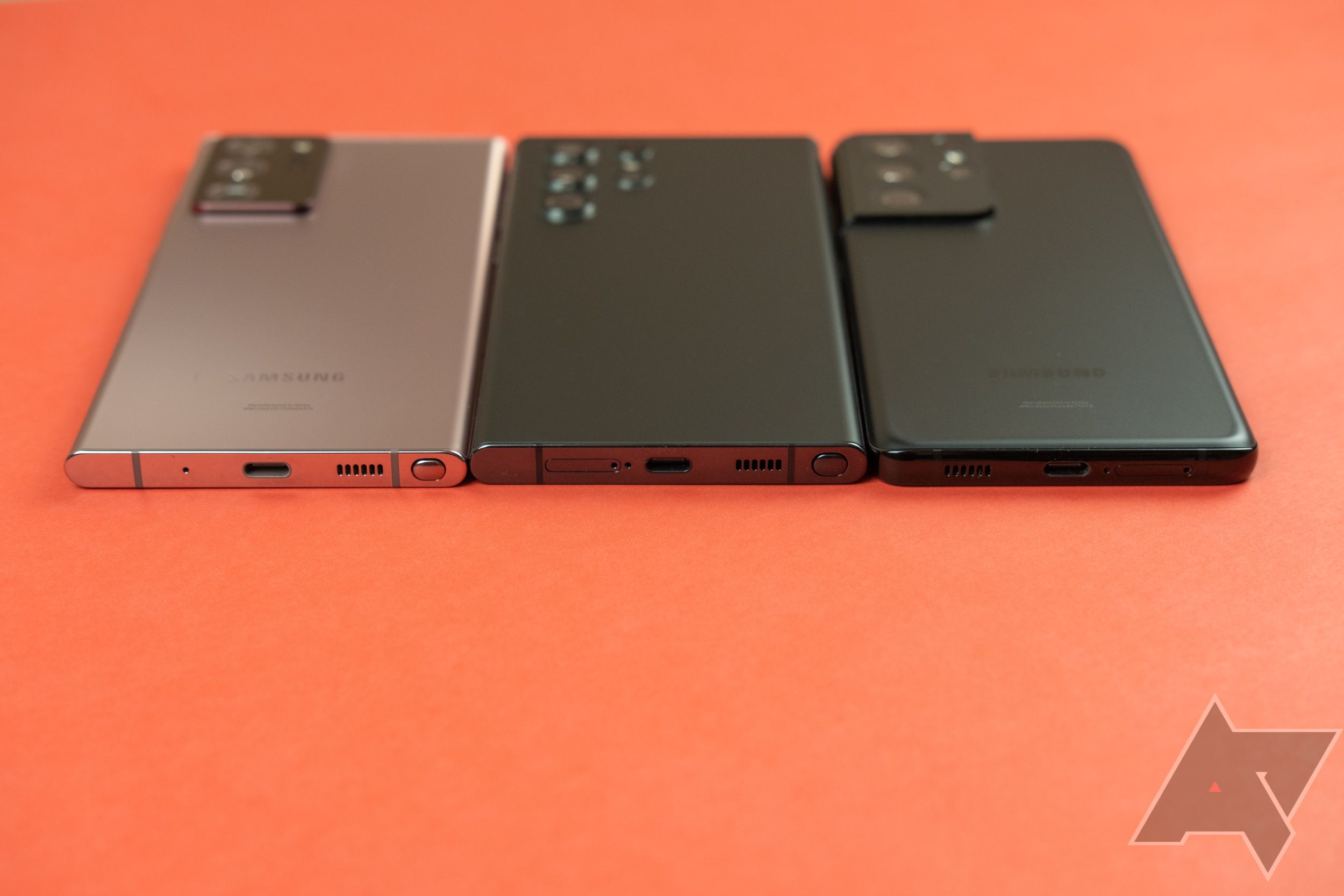
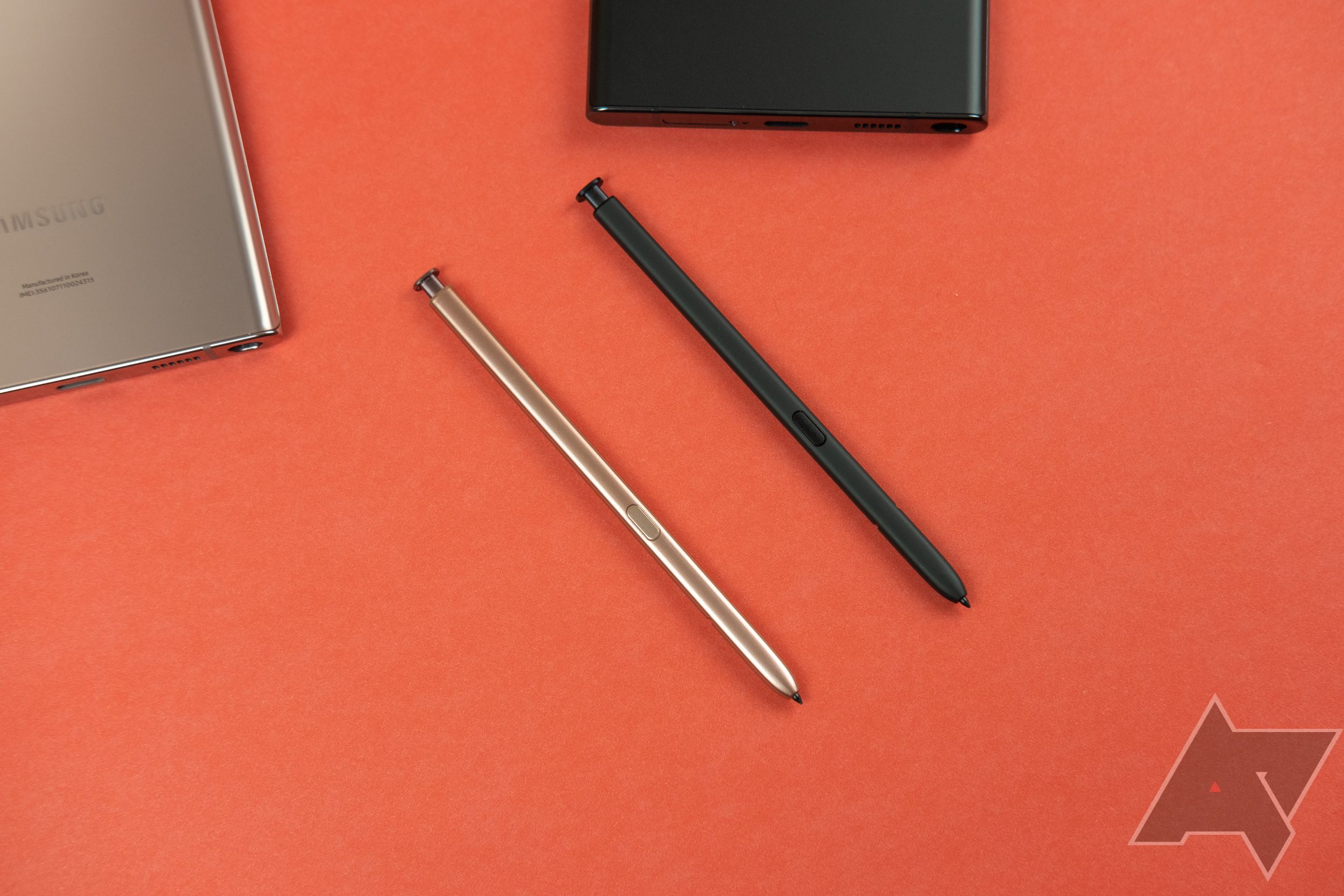
The S22 Ultra has flat caps at the top and bottom, reminiscent of the Sony XZ series. In fact, the phone can stand up on its own, which isn't useful, but I think it's neat. Those caps merge smoothly into the metal rails running along the side. The "Armor Aluminum" frame lines up flush with the glass panels, like a continuous curve linking the front and back. There is more metal and less glass than the Note20 Ultra had, which makes for a smoother transition between materials and tighter seams. It's a beautiful piece of hardware, right up there with the latest iPhone Pro models.
Rather than bulk up the camera array with the frame extension of other 2021 and 2022 Galaxy S phones, the Ultra has its sensors isolated on the matte glass back. Our review unit is the "Phantom Black" colorway, which has a real 2001 monolith vibe. The only branding on the entire phone is an etched Samsung logo on the back, giving the phone a classic, elegant vibe. There's no IMEI number printed on the back this year, thank goodness. The pared-back frame makes the phone feel more balanced—the S21 Ultra is rather top-heavy by comparison. The S22 Ultra is 20g heavier than the Note 20 Ultra was, putting it at the top of the scale for non-foldable smartphones, so every little bit helps. Aesthetically, I prefer the minimalist design of the S22 Ultra to the Note's inelegant rectangular camera island. And bonus, the S22 Ultra can lay almost flat because of it. That's refreshing.
Speaking of refreshing, the screen does that up to 120 times per second, and the resolution clocks in at 1440 x 3088. As mentioned above, the screen curves down slightly to meet the aluminum frame, but there's still plenty of flat real-estate on a panel measuring 6.8 inches. You should not buy this big, heavy phone if you're accustomed to one-handing your device, though. People like big screens, which is why smartphones are this enormous in the first place, but the quality of the panel makes up for that. The S22 Ultra has the best display I've ever seen on a smartphone. It's sharp, smooth, and the outdoor brightness is unreal. Samsung says the S22 Ultra can hit 1,750nits, enough to make it easily readable under even the harshest sunlight.
It's a beautiful piece of hardware, right up there with the latest iPhone Pro models.
Under the display, you'll find the same ultrasonic fingerprint sensor that was in the last Samsung flagships. Samsung says the algorithms have been improved further, but I didn't have any issues with the S21. There's no issue getting the S22 Ultra to unlock, either—Samsung's in-display biometrics work swimmingly today. It takes barely a tap for the phone to recognize my fingerprint, and the sensor is in a very comfortable location: aligned with the middle of the bottom home screen row.
The buttons on the right edge have a touch of pre-travel before the click, which can make them feel spongy compared to some phones. That said, they don't wobble, and the tactility is great. I'm always surprised how phones that still cost $600-800 can have wobbly power buttons, but you can't get away with that on a phone that costs $1,200. There's also a 5G radio window on this side, which is the sole element that takes away from the phone's slick aesthetic. The bottom cap has the USB-C port, a speaker (stereo configuration with the earpiece), a microphone, and, of course, the S Pen.
The S Pen in the Galaxy S22 Ultra picks up where the Note left off, right down to the fidget-friendly push-push ejector. As it happens, the dimensions are identical to the Note20's stylus. It's small enough to fit inside the phone, so it's not comfortable to use for long periods. Despite being hard to carry around, the add-on S Pen from last year's S21 Ultra was more usable. The S22 Ultra's pen feels more matte than past versions, which gives more resistance when inserting and removing, but it's otherwise the same S Pen experience with Bluetooth connectivity and an accelerometer. The gestures still don't work very well, and app support is slim, but I do like using the S Pen as a camera remote.
Samsung includes next to nothing with the Galaxy S22 Ultra, despite the high price tag. It's just the phone and a short 3-foot USB-C-to-C cable. As annoying as this is, it's not surprising. Even the $1,800 Z Fold3 doesn't include a charger. If you're in need of one, we have a list of the best Galaxy S22+ & S22 Ultra chargers.
Software, performance, and battery
The Galaxy S22 Ultra ships with Android 12 and One UI 4.1. If you've seen One UI 4, and we've covered it extensively, there's not too much new to see. You still get a middling implementation of Material You, support for icon packs, and various improvements to the stock apps and widgets. One nice bonus, Samsung is finally using Google Messages in the US instead of Samsung's own messaging app, but it's a slightly tweaked version identified in the package name a "Samsung dynamic." There are a few icon changes, and the UI shifts downward to be more one-handable in the style of One UI.
I'm happy that Android is emphasizing widgets again—all it took was Apple caring about them. In addition to the new widget designs from One UI 4, version 4.1 on the S22 Ultra adds a number of Smart Widgets that ape Apple's Smart Stacks. Samsung's version comes in a few different sizes, allowing you to stack multiple widgets in a single item that you can swipe through on the home screen. Smart Widgets will also automatically switch to show you the most relevant information, but that's mainly of use if you're deep in the Samsung ecosystem. Even if you don't care about that, there are still use cases. I'm using a Smart Stack to keep multiple playback widgets handy without wasting home screen space.
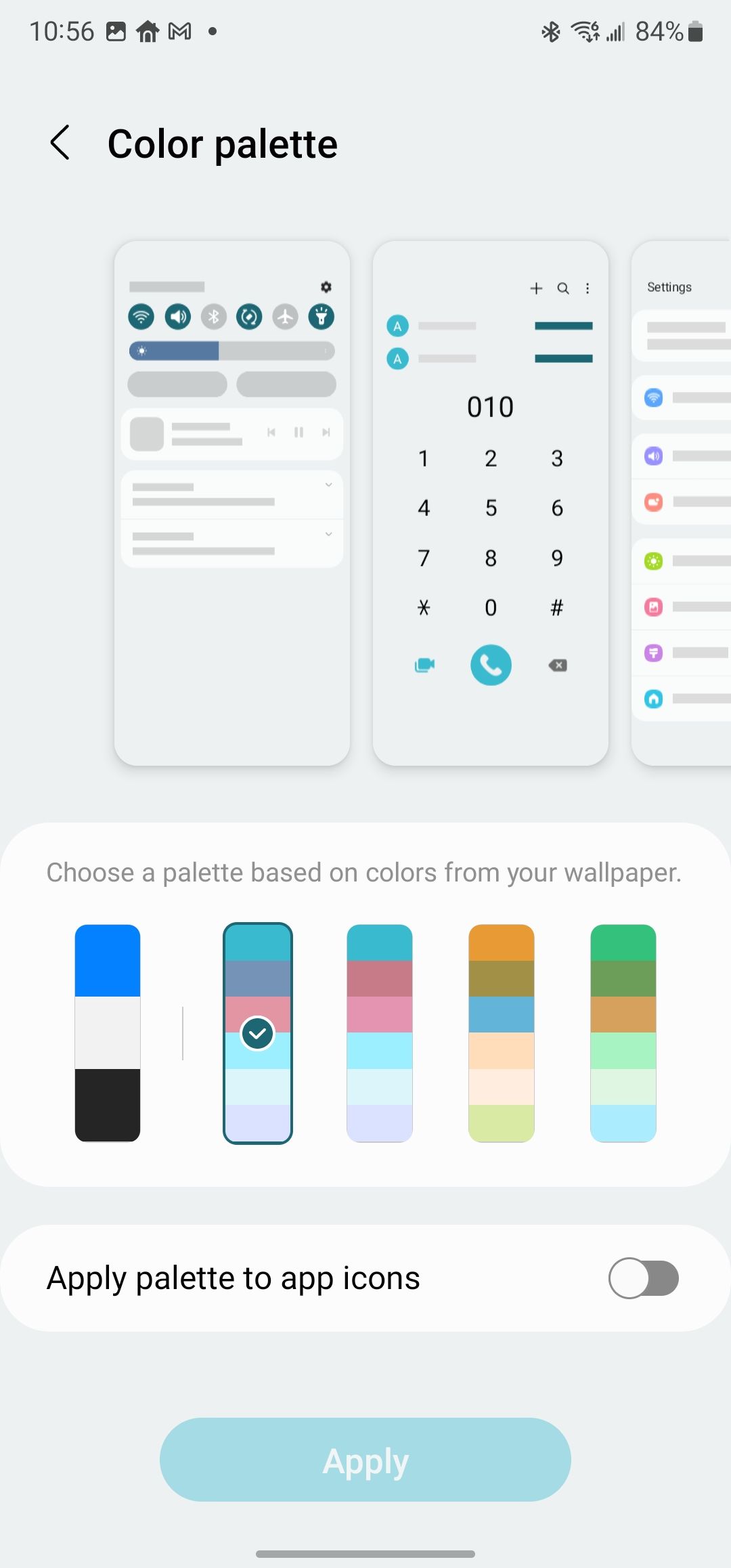
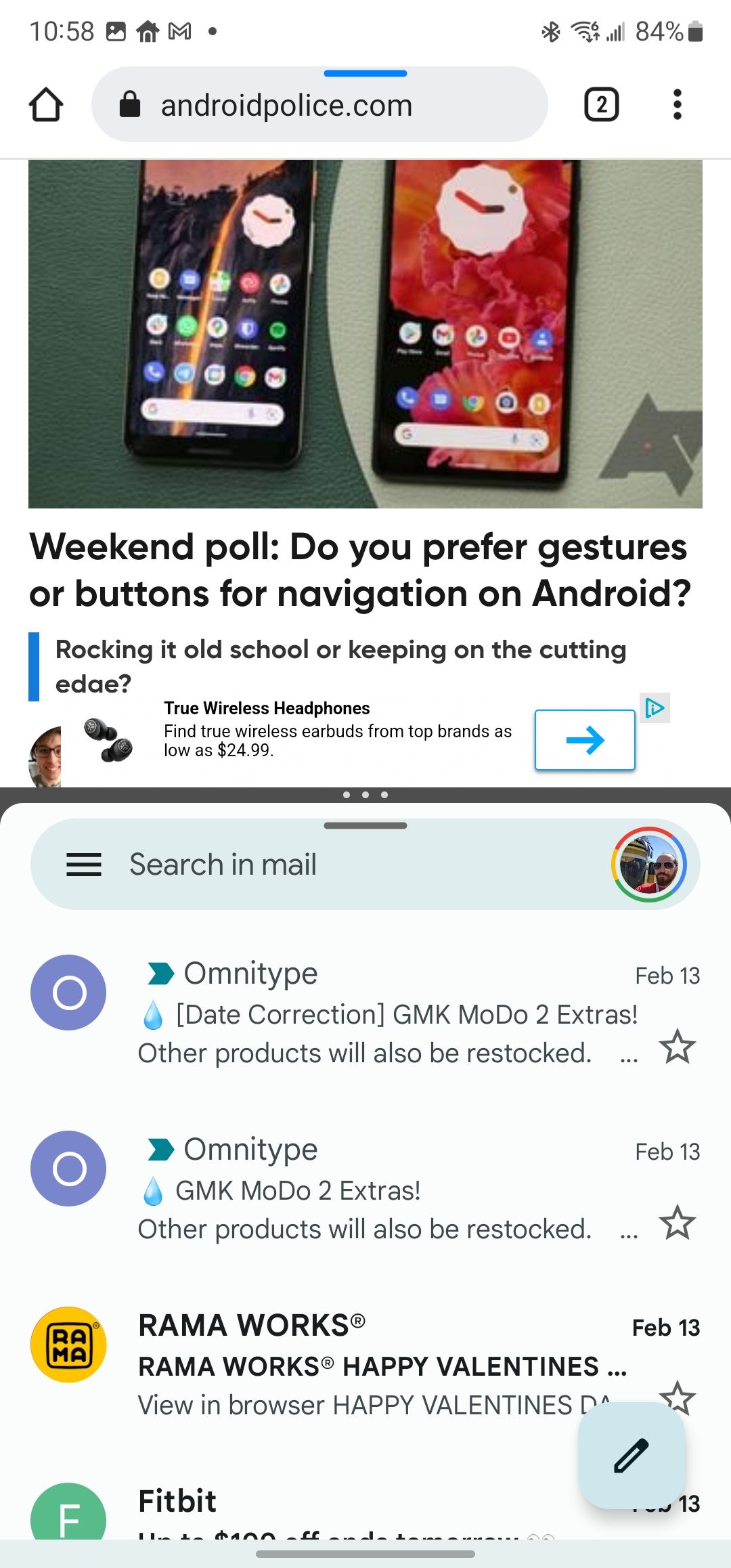
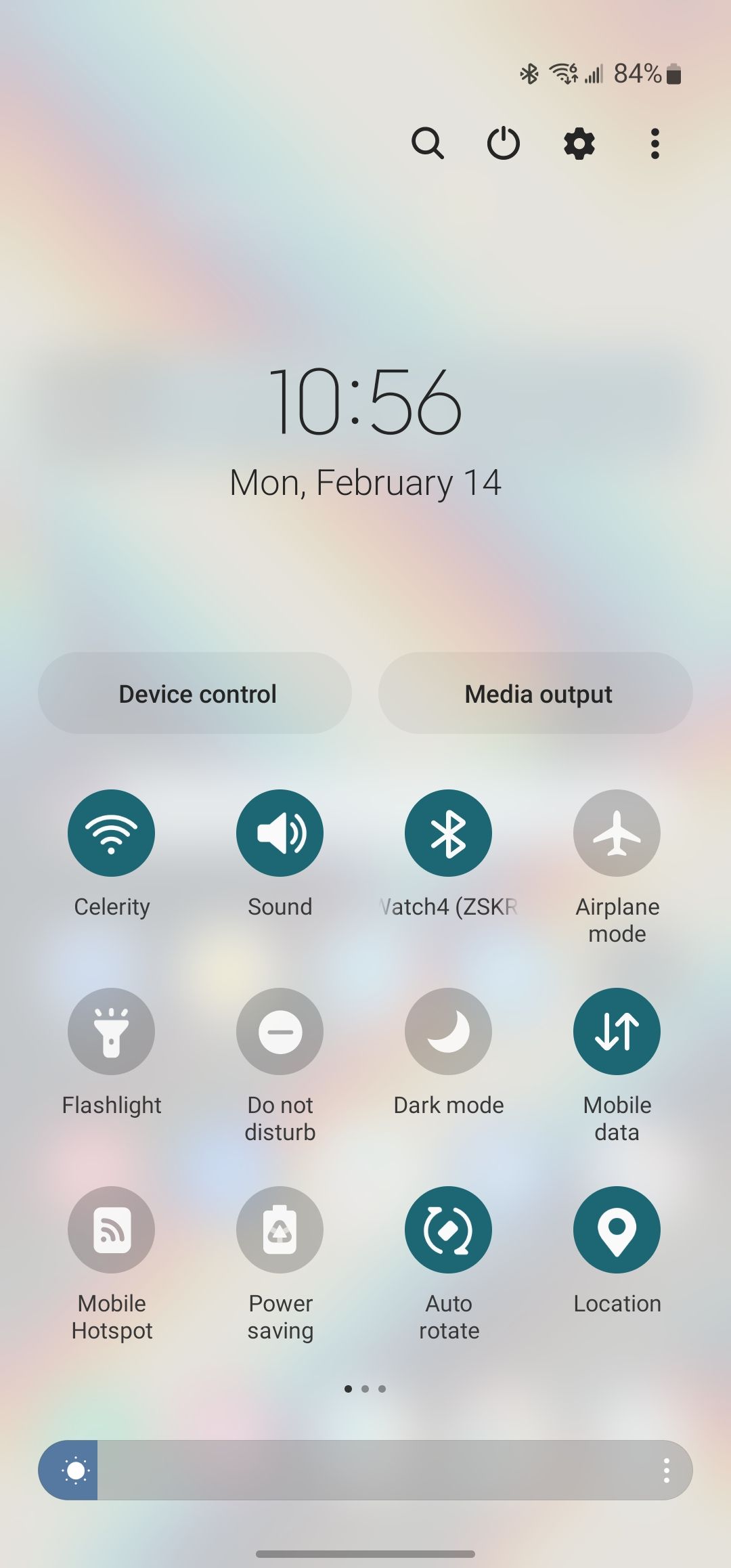
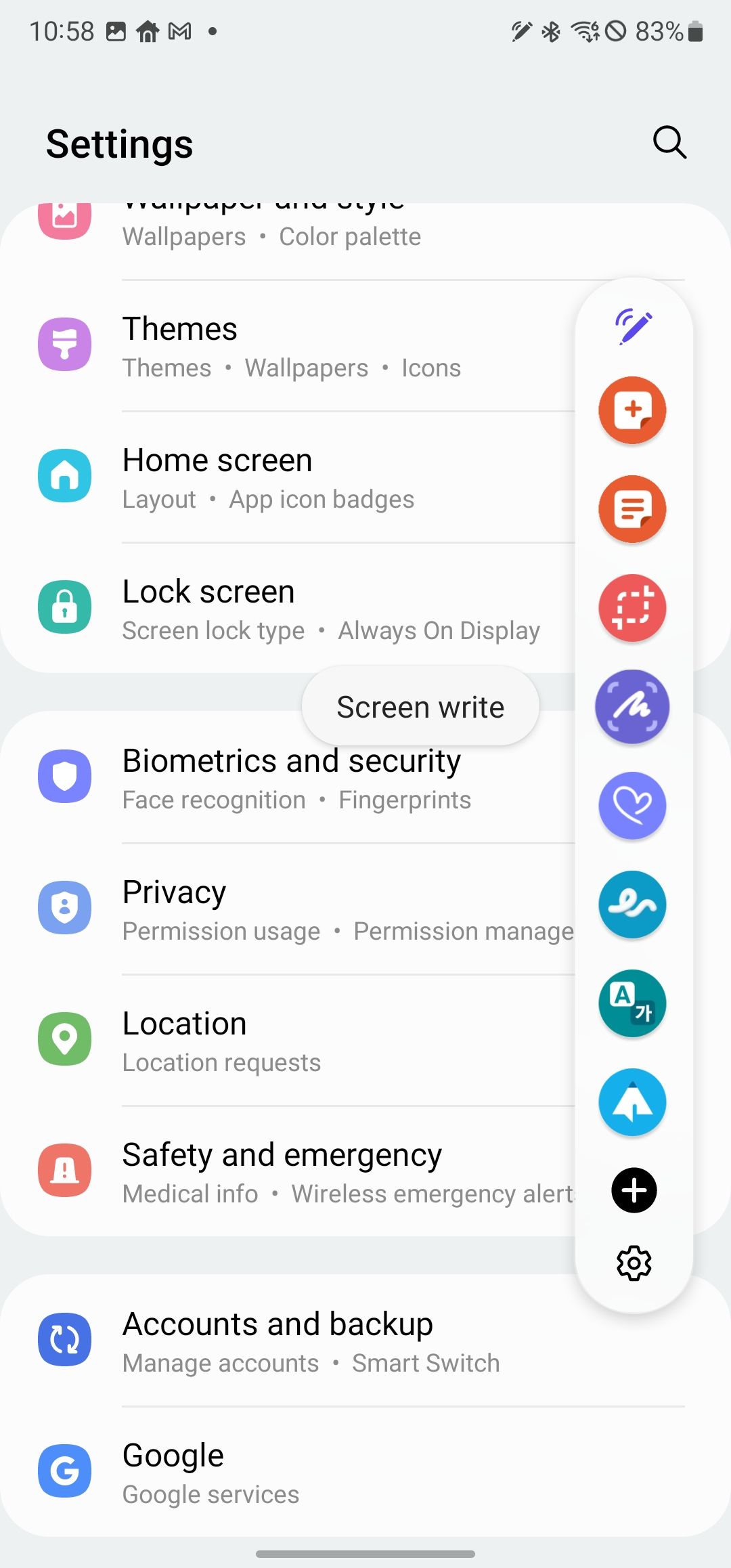
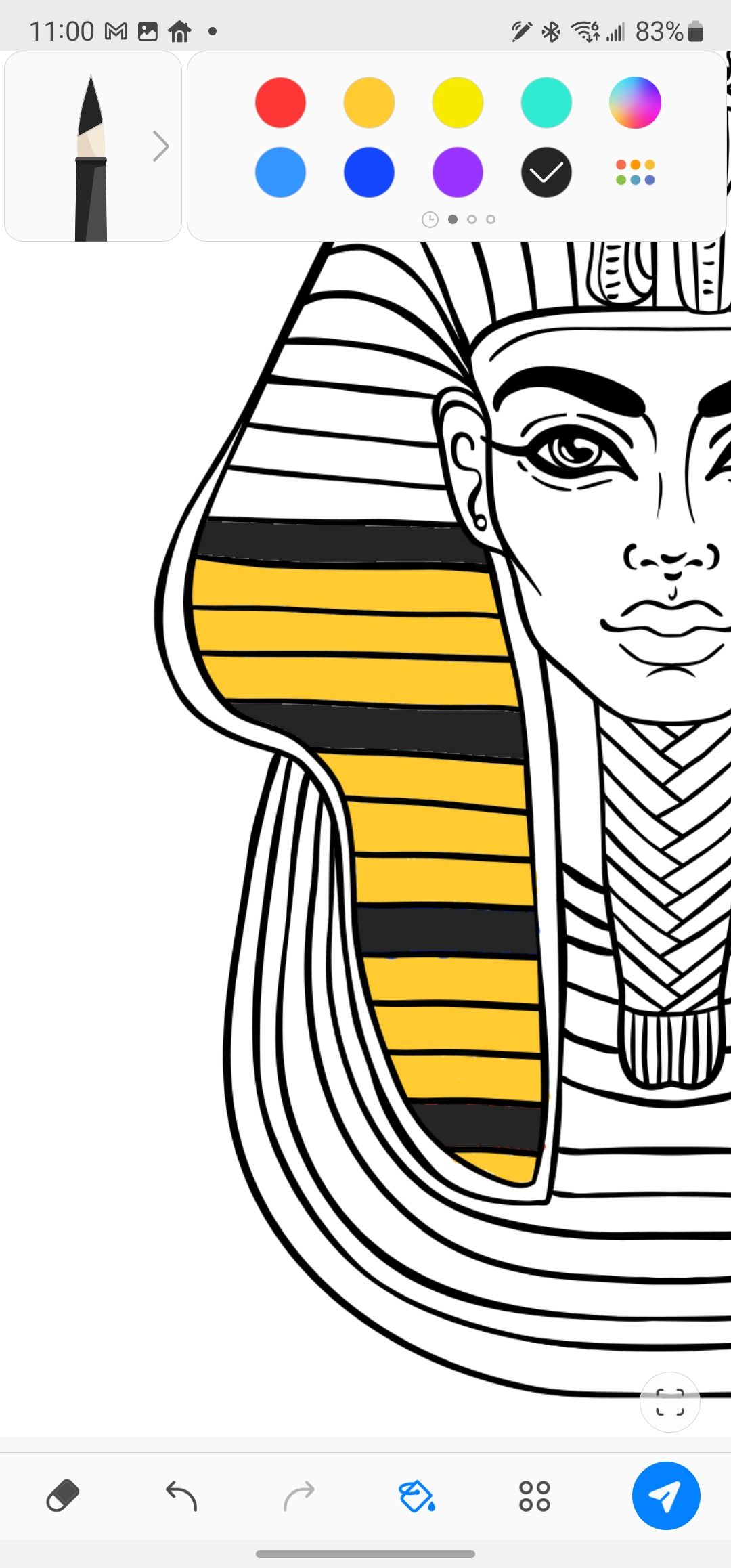
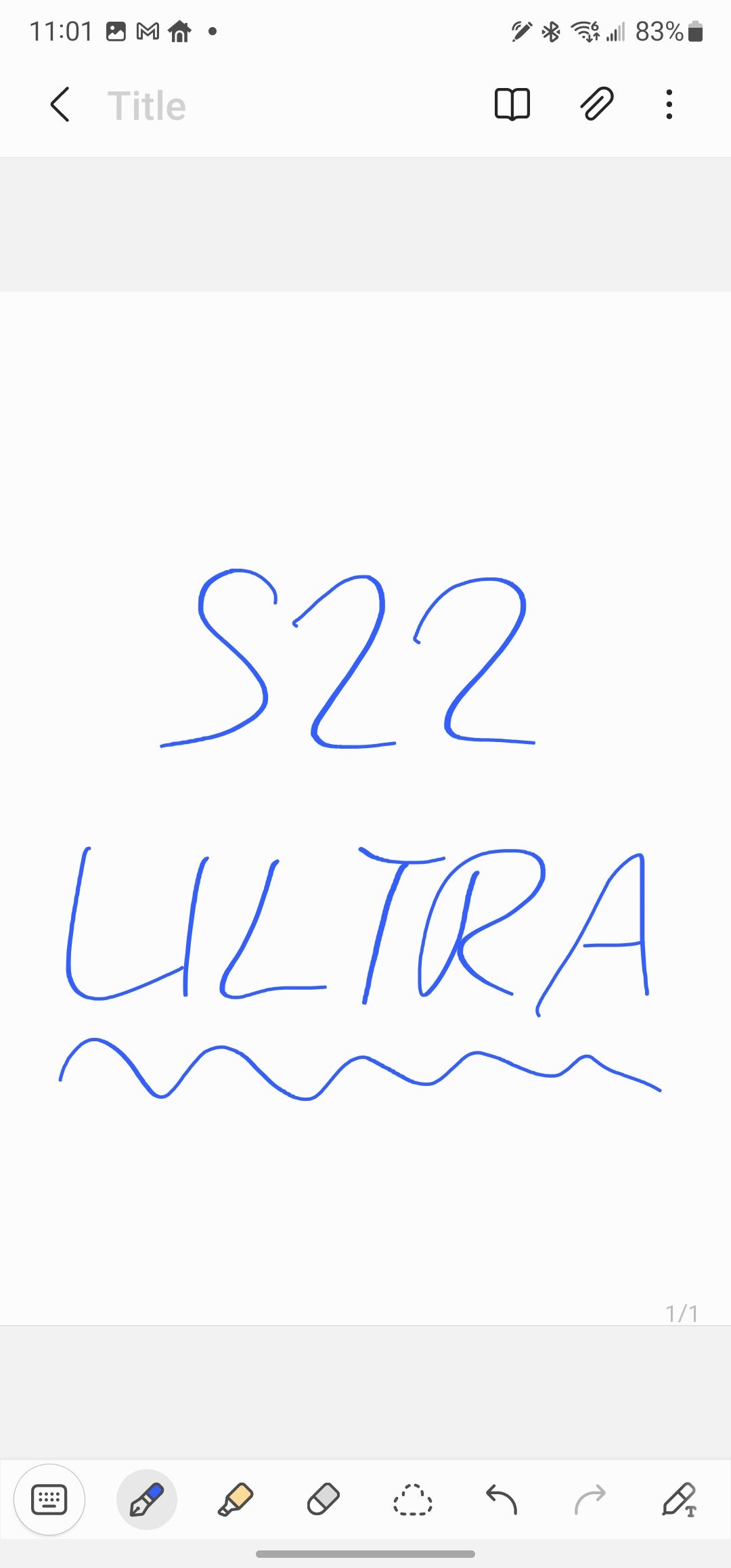
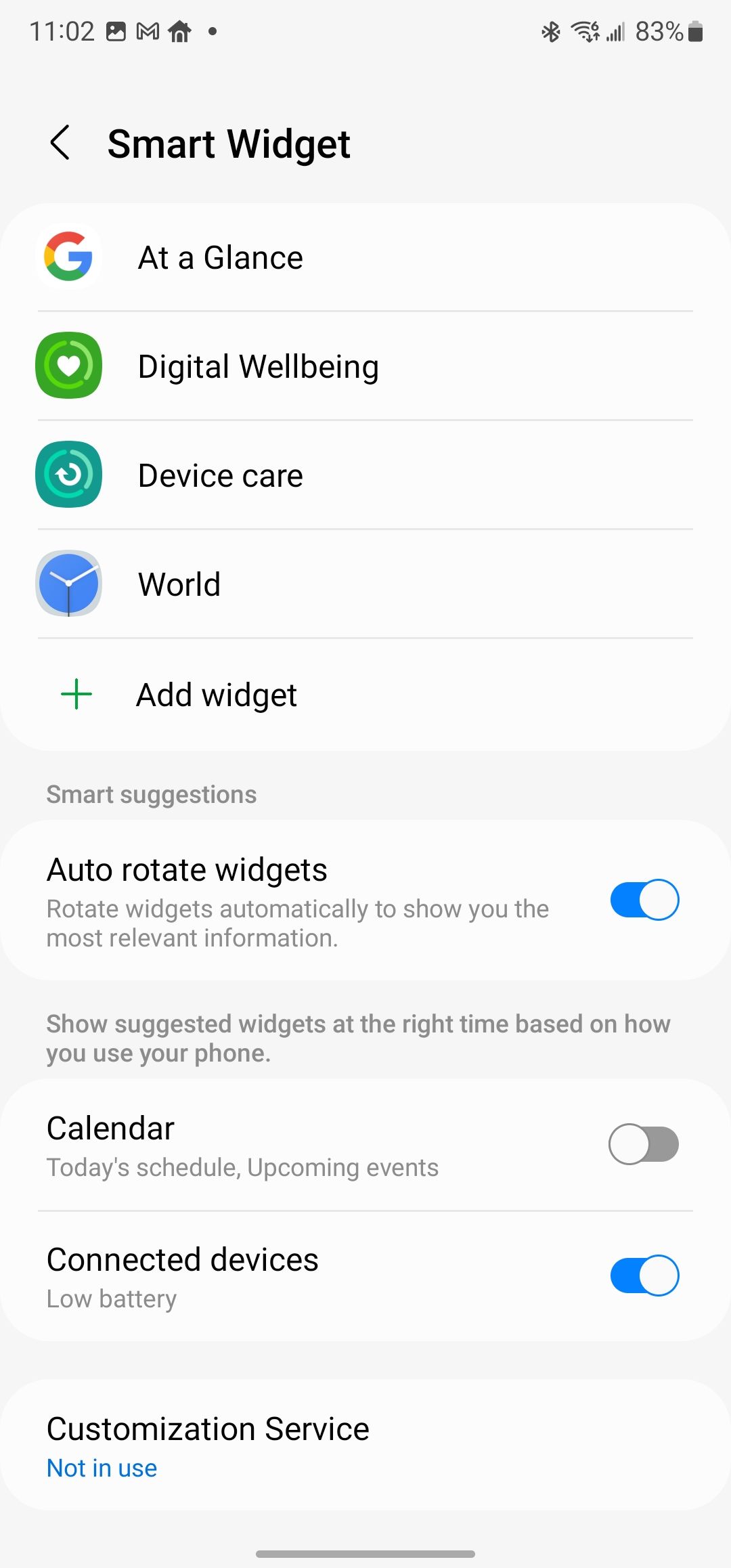
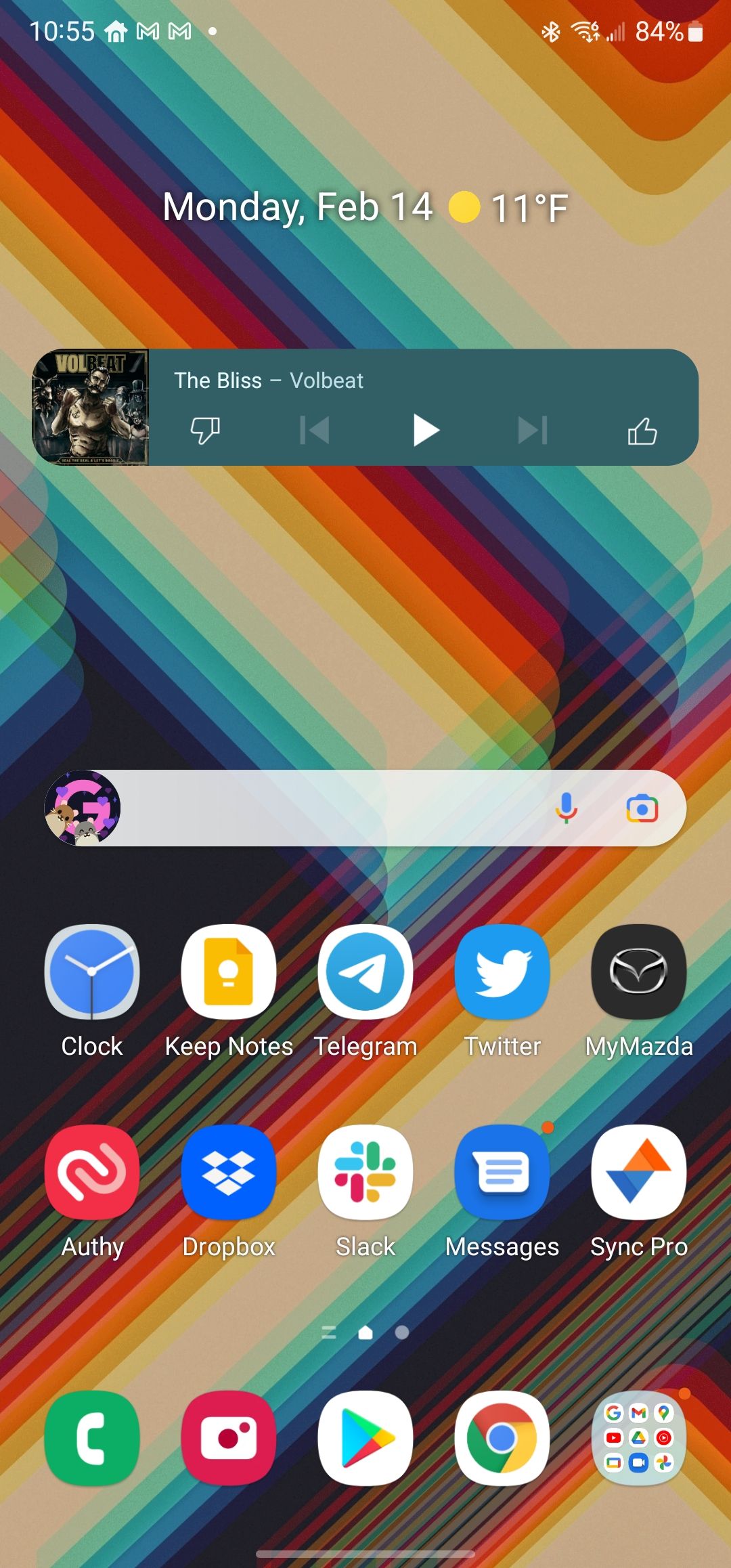
Samsung has not expanded its support for Material You theming, but it has expanded the color palette. You now get more tones in each theme spread around the OS. Likewise, Samsung hasn't fixed RAM Plus, a feature that steals your storage to make virtual memory, but at least you can now choose the amount of storage sacrificed. You can go as low as 2GB or as high as 8GB. These phones already have 8GB of RAM minimum, and I expect that will be plenty. My review unit has 12GB of RAM, and it does feel like Samsung is making smarter use of it. Overall usage RAM remains higher, and my apps stay alive in the background more reliably.
This phone isn't a "Note," but it has all the S Pen features you'd associate with the Note. You can launch apps from the Air Command pop-up, use handwriting input, more skillfully edit screenshots, mark up documents, doodle with screen-off memo, and more. It's all built into the S22 Ultra, and it works. Samsung used to leave neglected features in its software to contaminate the experience, but everything in One UI 4.1 feels intentional. I don't love all of Samsung's decisions, though. Despite being an unlocked device, our unit came with apps like Facebook and Office pre-installed, and it defaults to installing bloatware like LinkedIn and Spotify during setup. Luckily, you can remove or disable just about everything.
We can't talk about the S22 Ultra's software without addressing updates. This phone ships with Android 12, and Samsung is now promising five years of update support, and more interestingly, four years of major OS updates. So, the S22 Ultra will get Android 13, 14, 15, and 16. You can add this to the list of things that help to ameliorate the S22 Ultra's high price tag. That's longer update support than Google's Pixel phones, although Samsung won't be as quick to update as Google, especially after the S22 series is yesterday's news.
The S22 Ultra runs on the same Snapdragon 8 Gen 1 as the other members of the S22 family. There are plenty of benchmarks floating around, so I don't think anything is gained by throwing more numbers at you. Having lived with the phone this last week, the S22 Ultra feels uncompromisingly fast. Intense games like Genshin Impact and Fortnite run as well as they ever do on a phone, and you can split-screen apps without any detectable slowdowns. My only concerns relate to the wireless radios. On several occasions, I've seen the cell signal drop to zero before returning to normal, and Bluetooth sometimes refuses to play nicely with select devices. I'm running pre-release software on this device, so these foibles could be gone by launch day.
With all the powerful hardware, I had some worries about battery life. Without making any major settings changes, the S22 Ultra lasts me a little over 24 hours with around six hours of screen time. That includes messaging, web browsing, light gaming, music streaming, and videos. In the realm of flagship phones, this is about as good as it gets. There are definitely phones that will last longer on a charge, but the majority of them are much less powerful, and therefore also cheaper. If you want a phone that performs like the S22 Ultra with its flagship chipset and 1440p display, there's going to be a hit to battery life.
Samsung boosted the maximum charging speed to 45W, something it experimented with on the Note10 family. However, it's unlikely you have a charger with the necessary PPS support to hit the maximum, but Samsung sells a wired charger suitable for those speeds. Sadly, even a $1,200 phone doesn't come with a charger these days, and I will never be okay with this. Luckily, the S22 Ultra is more cooperative with regular USB-PD than its predecessors. I've been seeing 30W with a regular high-wattage PD plug, which is still faster than most phones in the US.
Cameras
The Galaxy S22 Ultra has five camera sensors; four on the back and one on the front. I don't consider myself an expert on selfie quality, but I don't have any objection to this 40MP shooter. It has a respectable f/2.2 aperture, and the S22 family adds Camera2 API support to the selfie cam. That should make third-party apps a bit better. This sensor peeks through the punch hole at the top of the display—no under-display camera on this bad boy, but that's fine by me. The UDC on the Z Fold3 wasn't the best.
We've already posted some early impressions of the quad-camera array—check our gallery post if you want to see the images from each sensor separately. Having used the phone more, I'm still very happy with the camera performance. The 12MP binned shots from the 108MP sensor have excellent detail and dynamic range. The colors are delightful and punchy without being too over-the-top. That's not to say that they're always accurate. Samsung likes to push more saturated tones, but that does make them great to share on social media. If you spy any stunning vistas, the ultrawide camera could come in handy. It has very little edge distortion, so you could use it inside, too. Although, it's hard to imagine a scenario in which you'd want to use it over the more flexible 108MP primary.
Like other Samsung phones, the S22 Ultra leans toward longer exposures, which can make motion hard to capture. However, in moderate light, the S22 Ultra manages to keep the primary sensor shutter above 1/100, and the ISO rarely peeks above 1000 unless you're shooting in night mode. Unlike most smartphone cameras, Samsung can produce good colors and accurate white balance even in challenging conditions. Samsung is making a big deal of the S22's improved low-light performance, and indeed, the S22 Ultra can turn dark to light with ease, but motion is hit-and-miss.
The two optical zoom sensors are new this year. They're both an IMX754, but one has a 3x lens and the other is behind a 10x folded periscope lens. These sensors feel like an improvement over last year's phone, pulling out more detail with brightness; as long as you don't crop them. Samsung's image processing can still have an air of watercolor when viewed up close. If the phone doesn't think there's enough light for the zoom cameras to work, it will crop the main sensor. This is nothing new—most phones with zoom cameras do this, but Samsung seems to change to the primary sensor more aggressively.
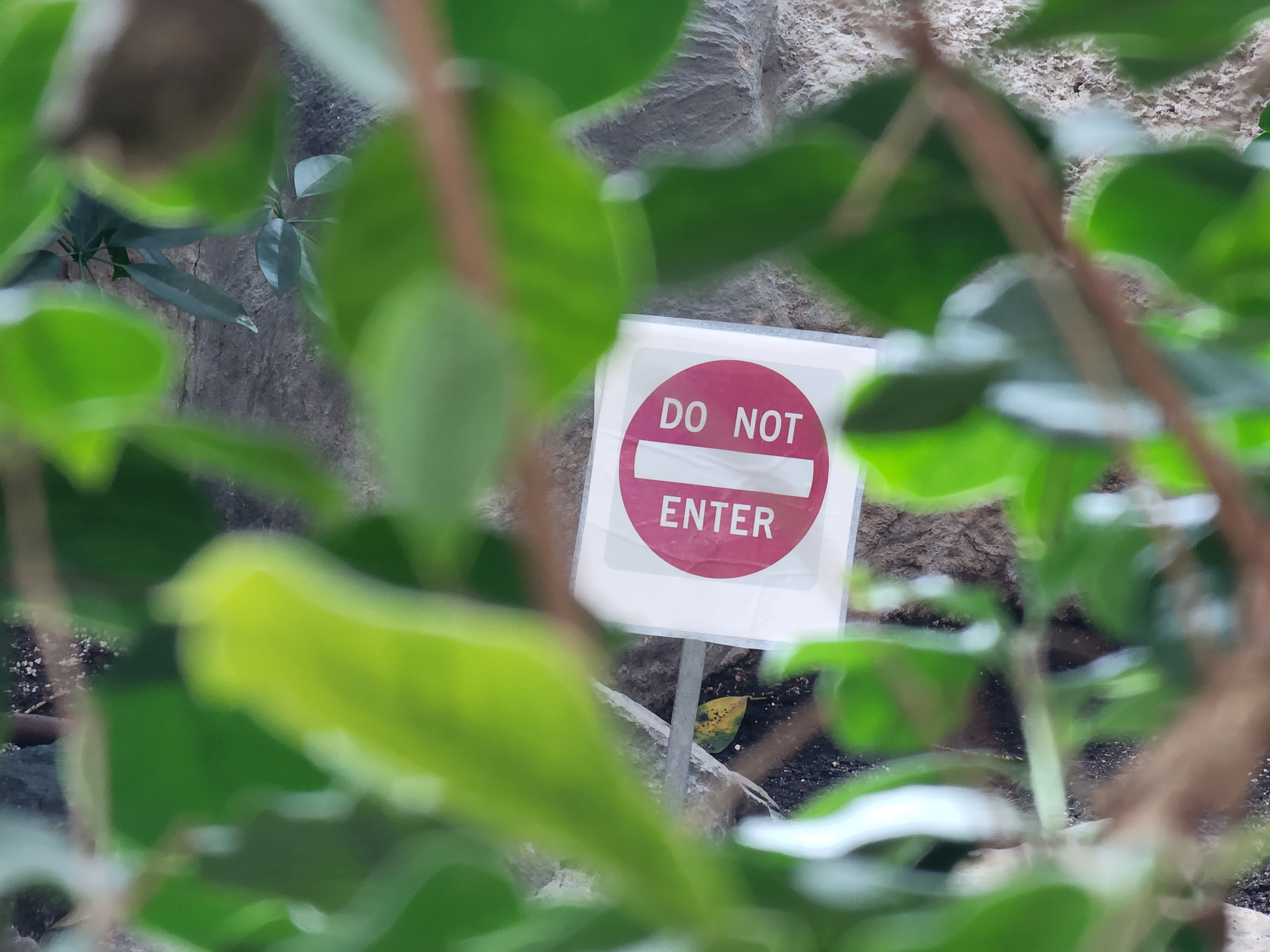













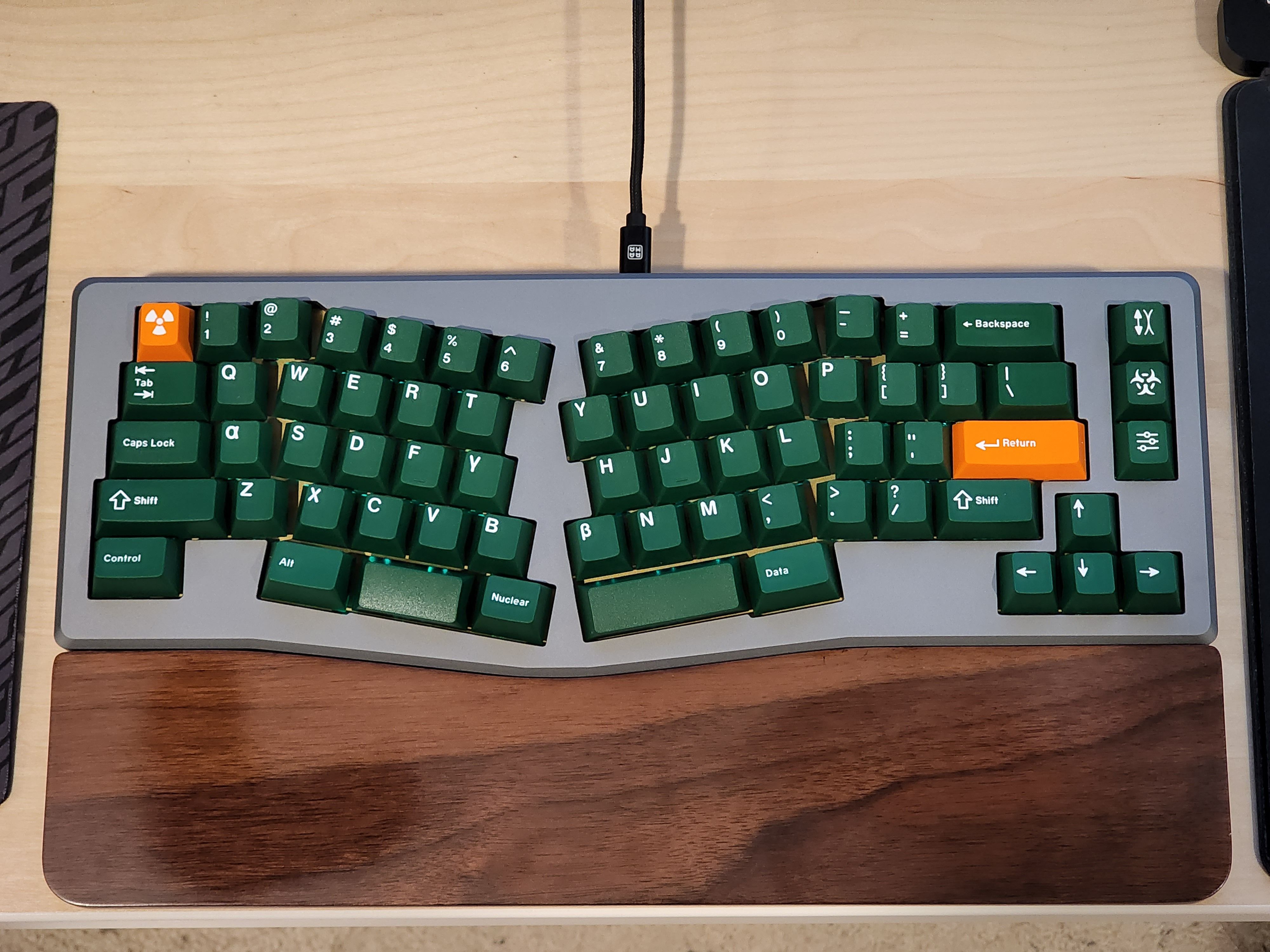



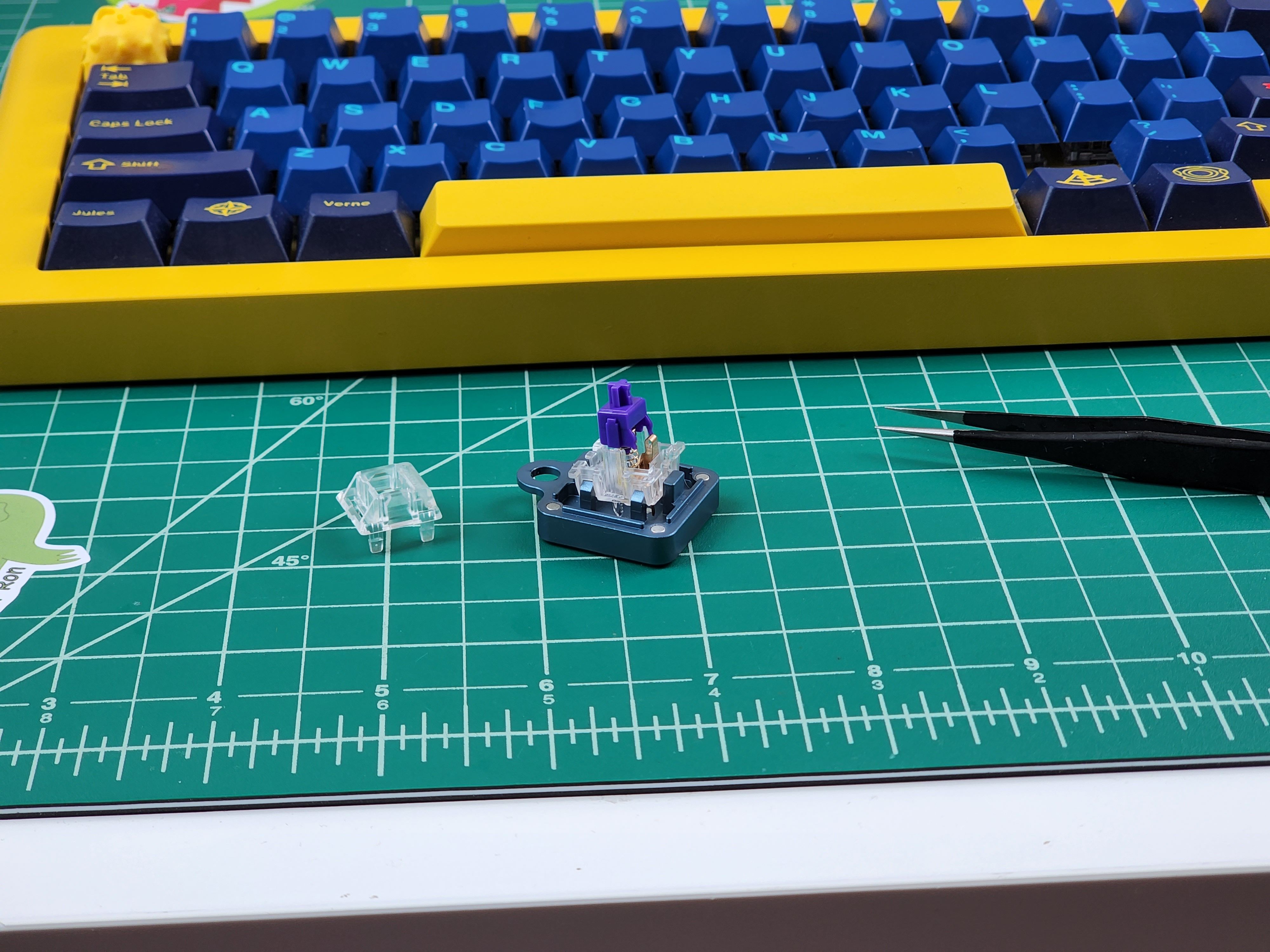

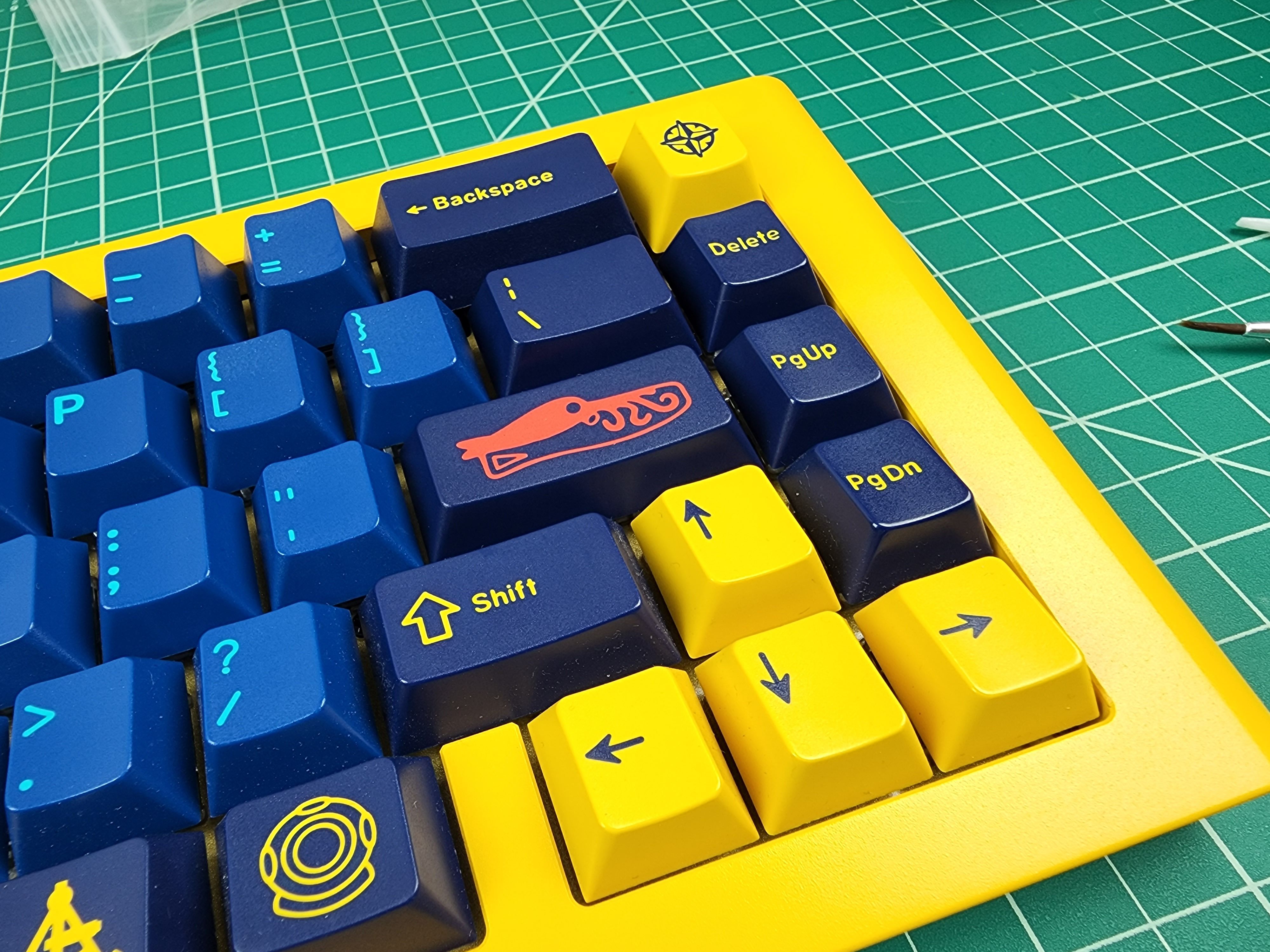
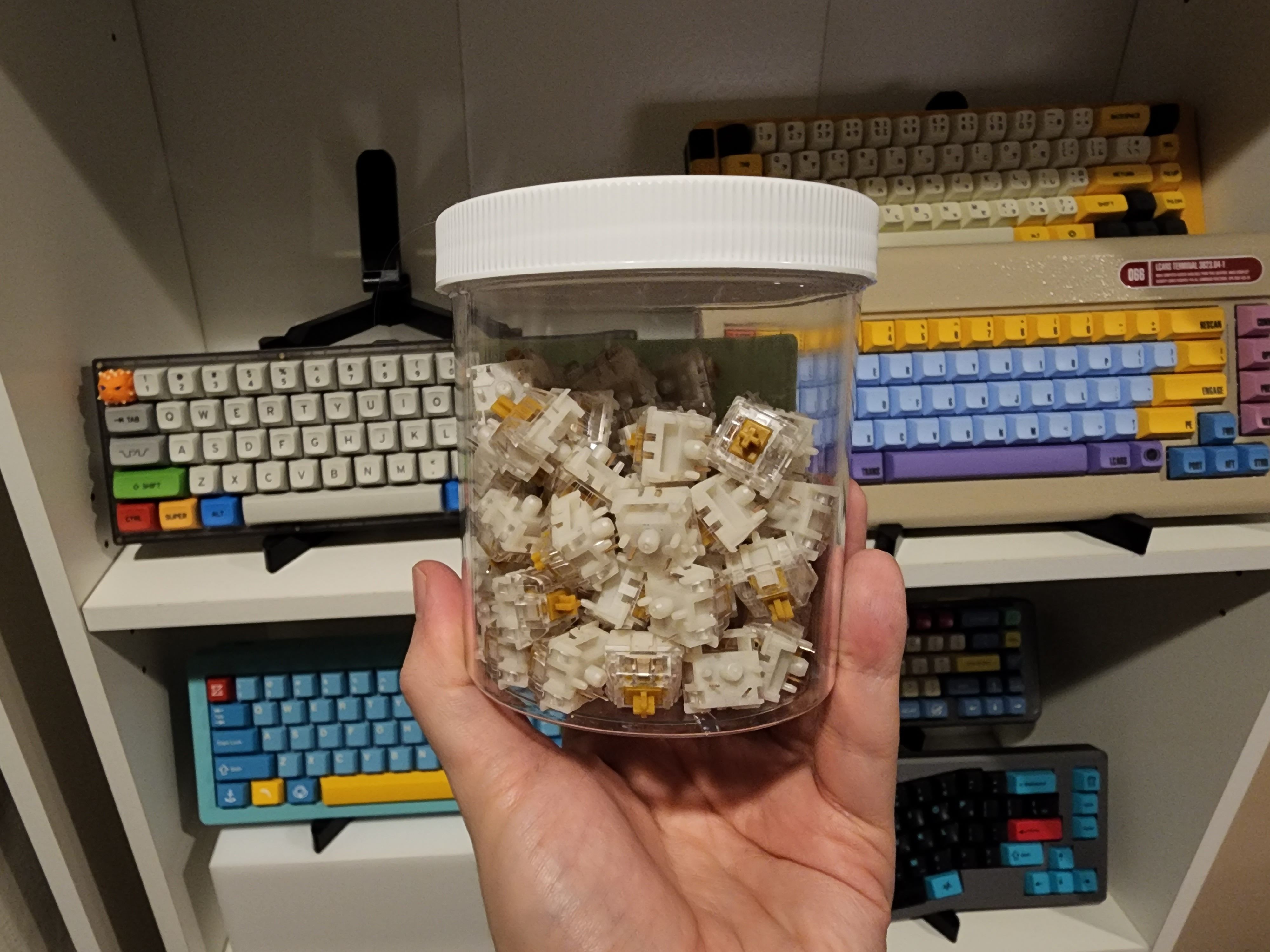


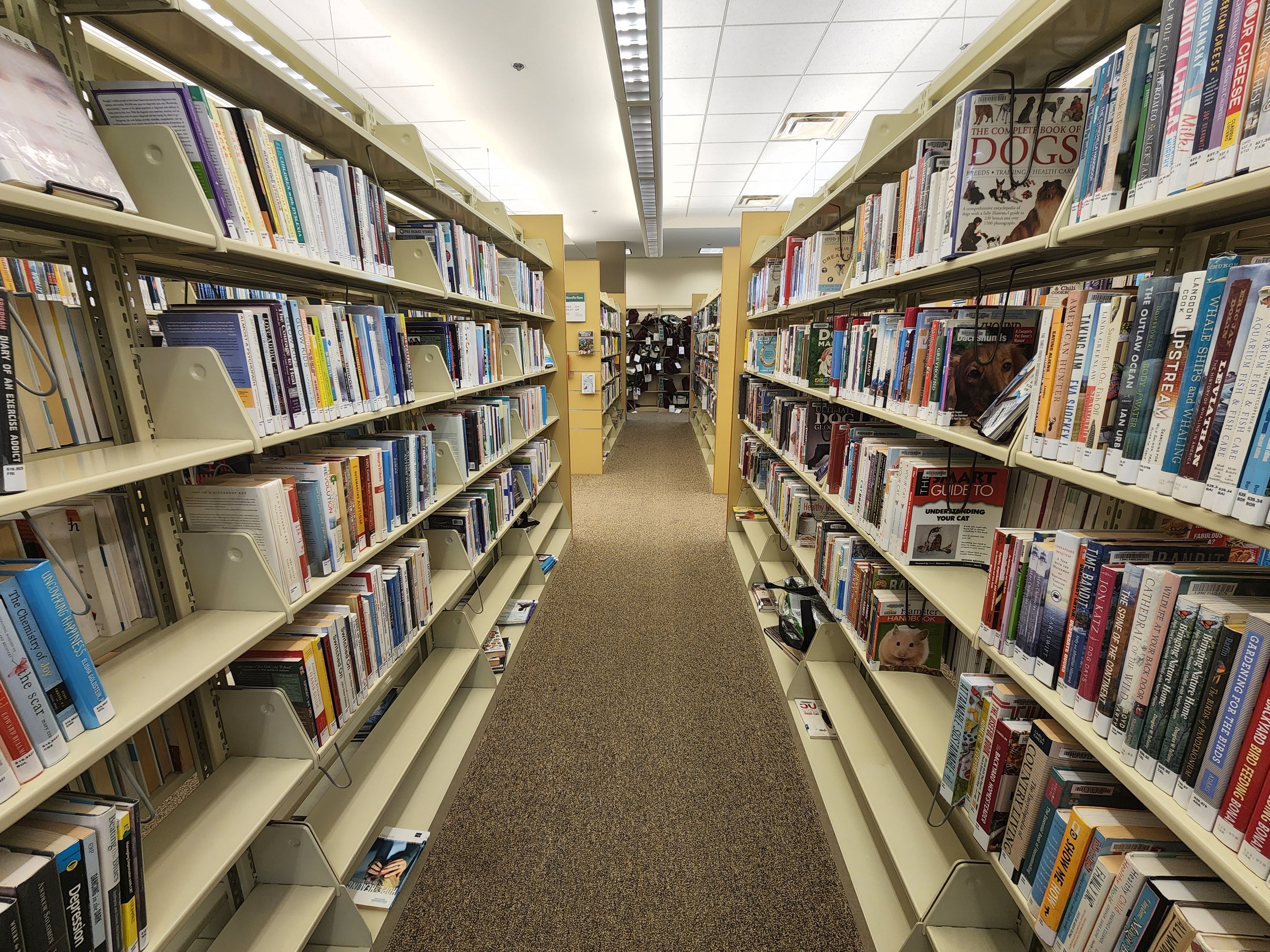


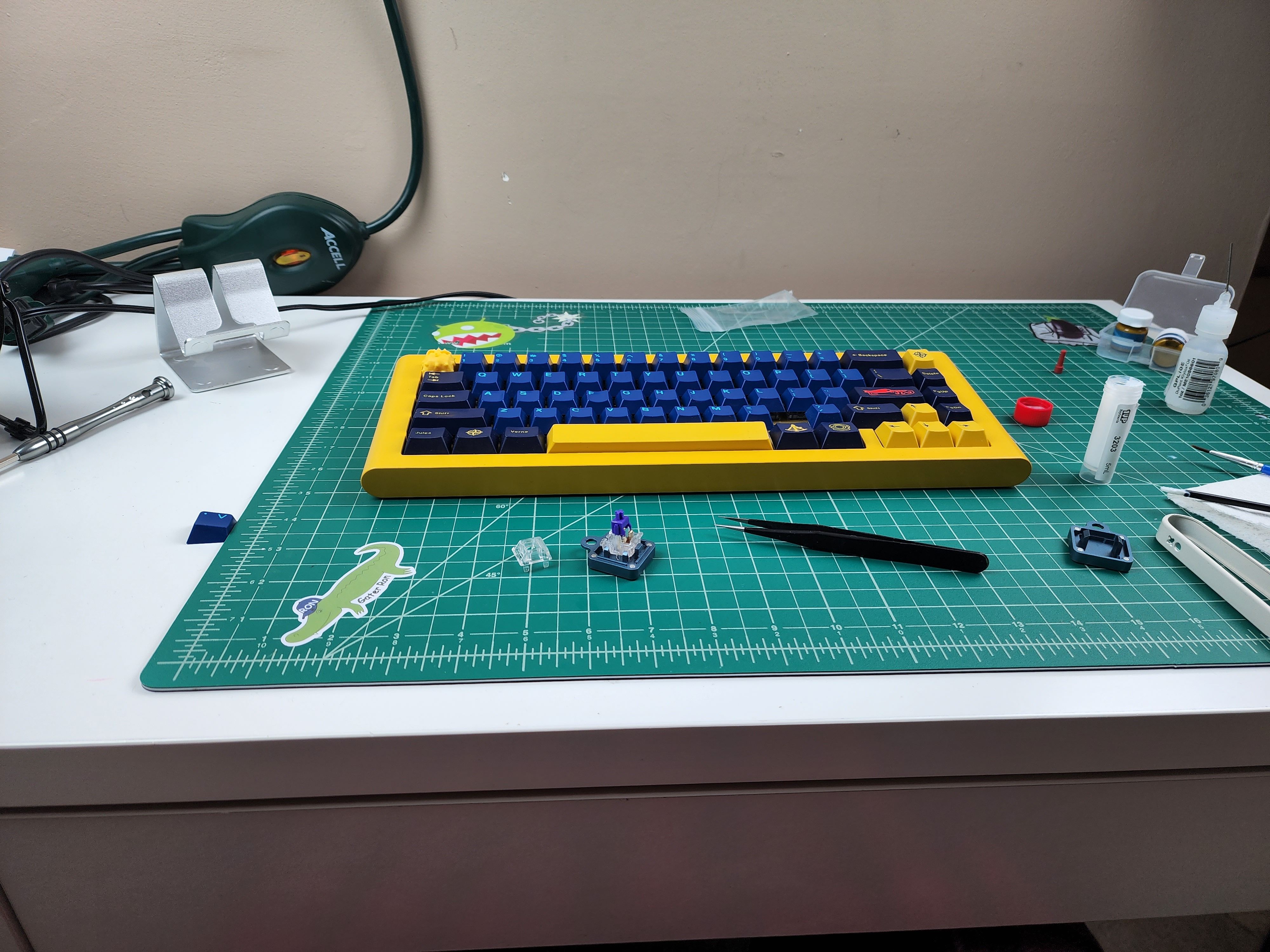
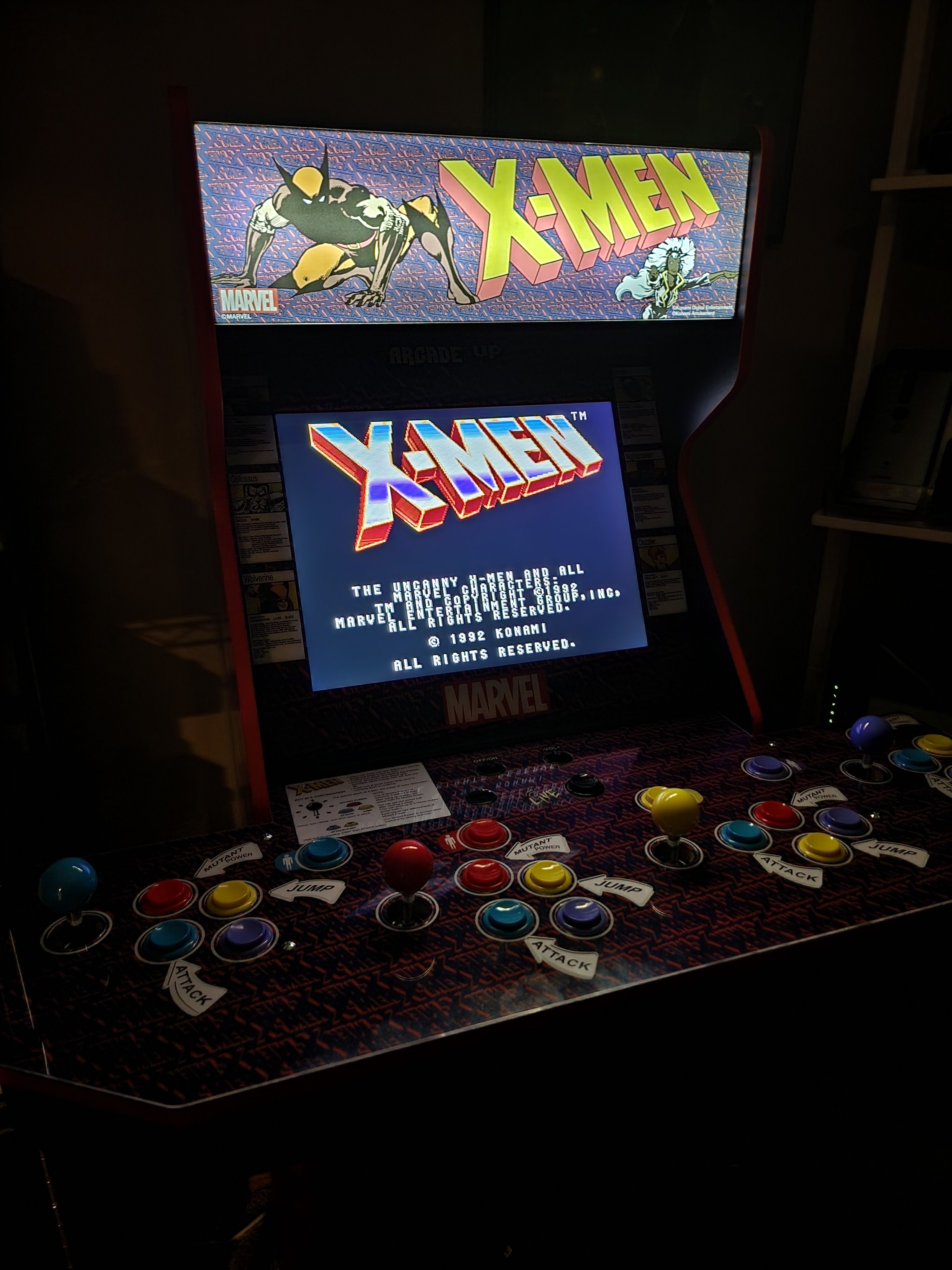
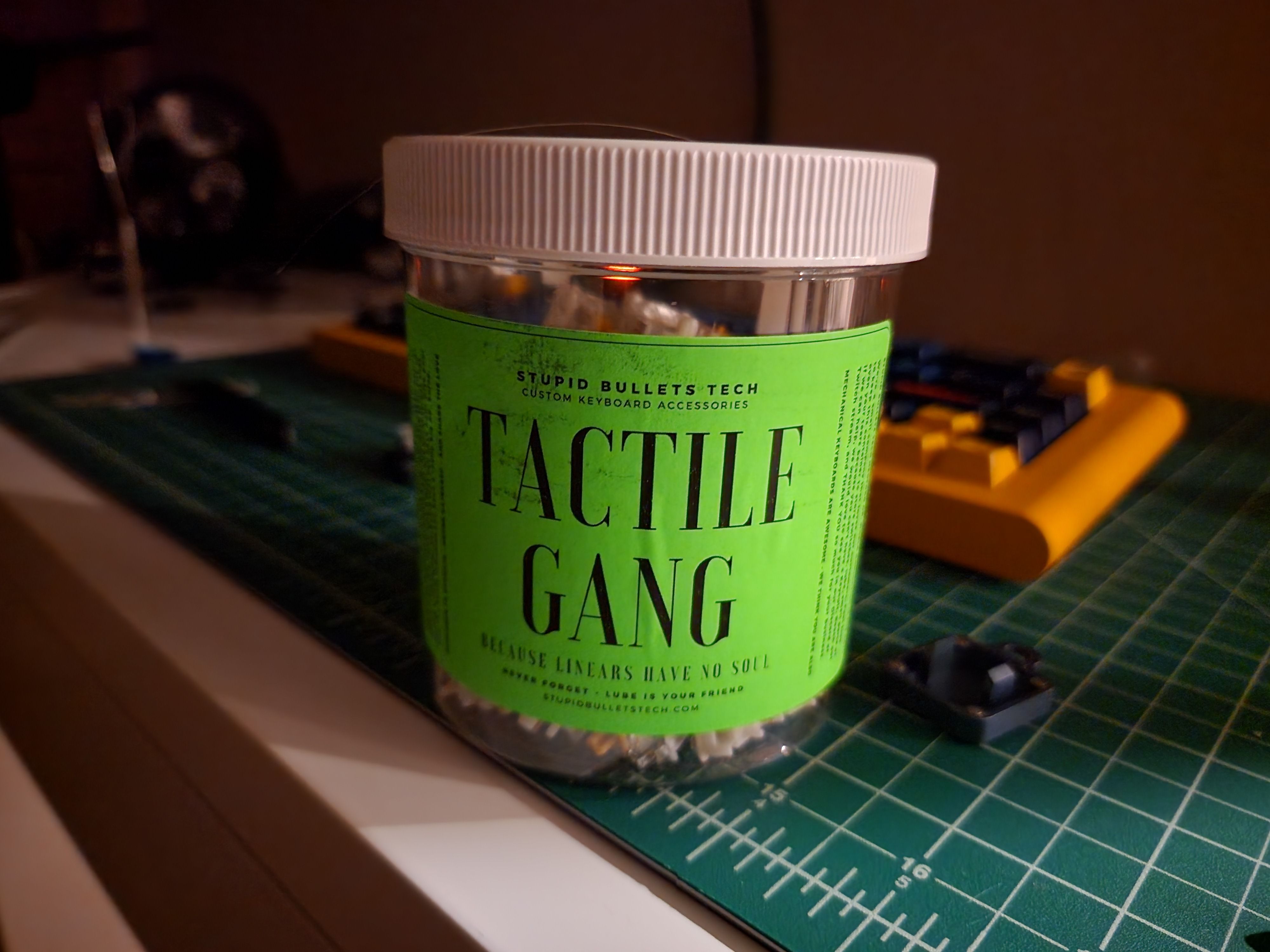


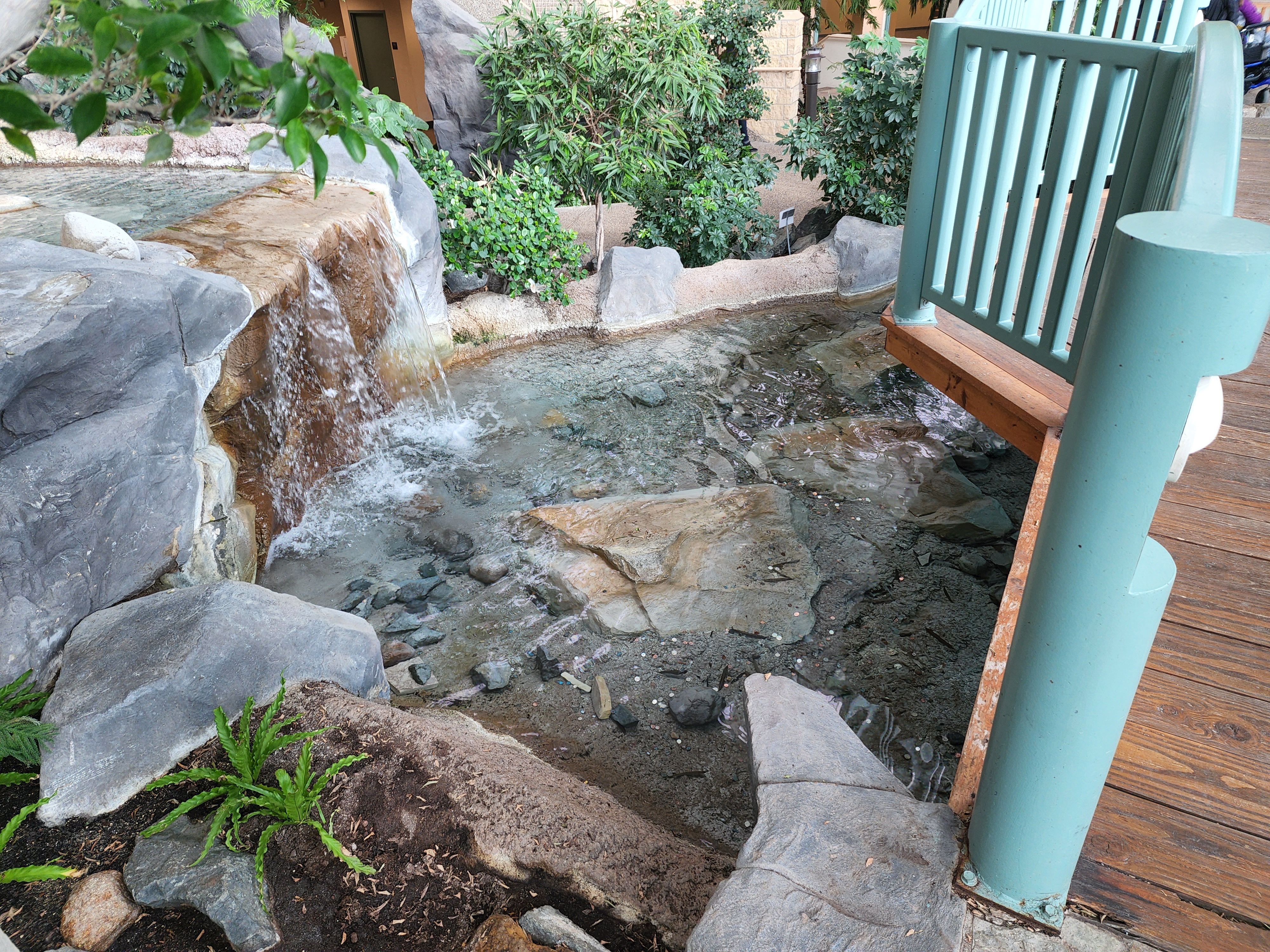

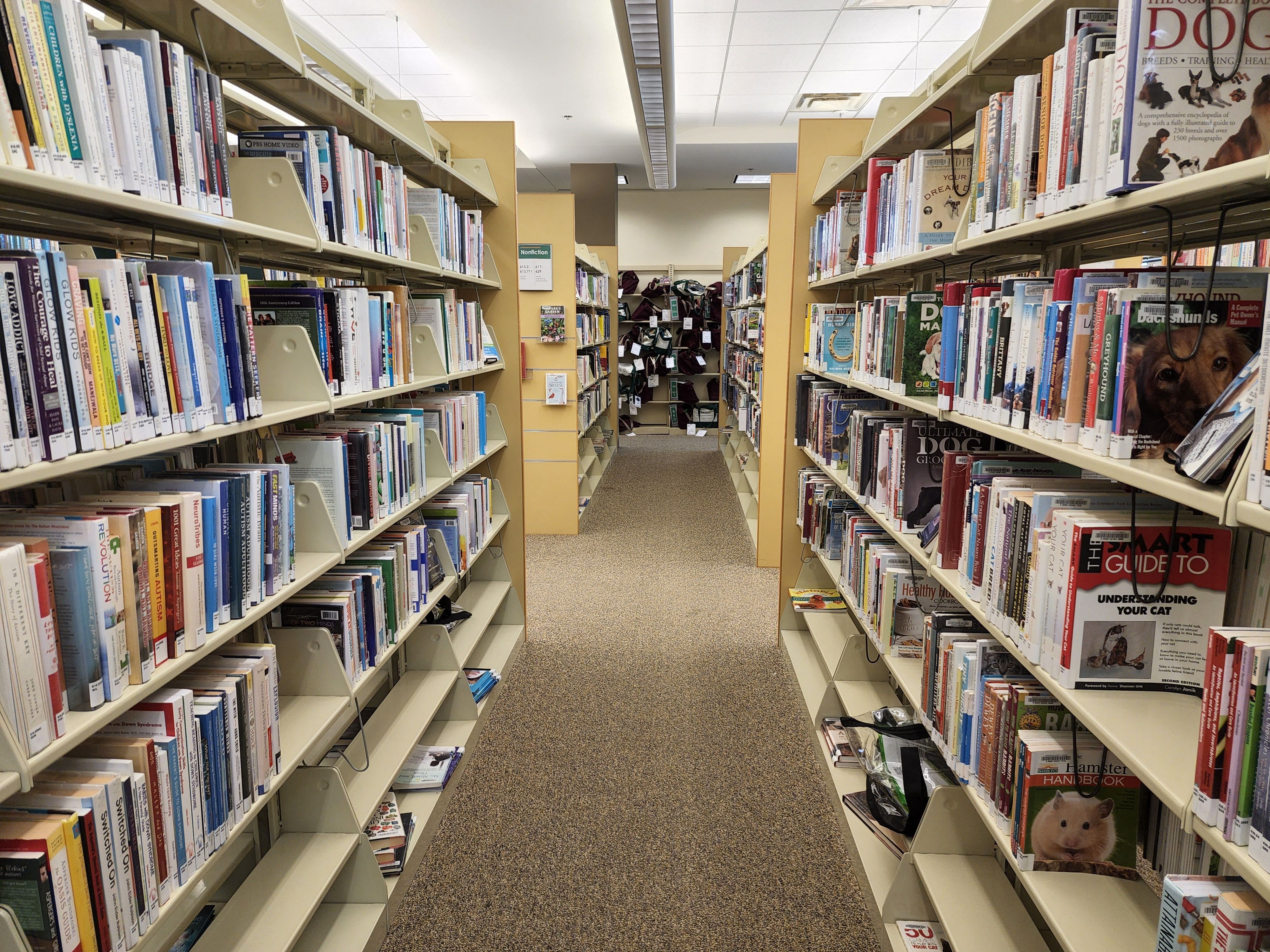
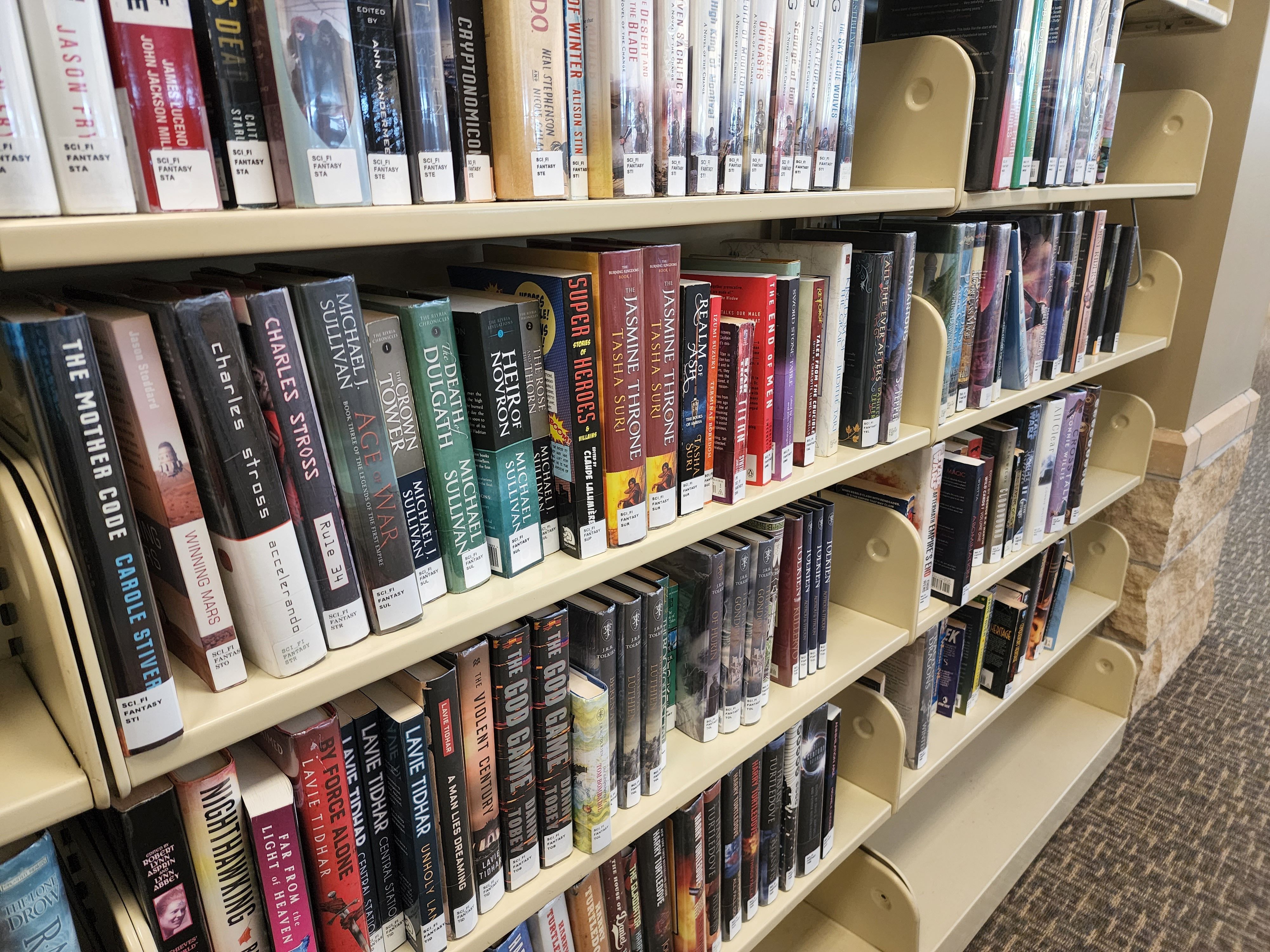



The zoom cameras have narrower apertures than the primary, so the shutter speed will be slower. In good light, these cameras are still fast enough to cope with a little movement but don't expect action shots. Even with optical stabilization, it's hard to keep the 10x perfectly still while shooting, but Samsung does an admirable job when you push the zoom into "Space Zoom" range. This is just Samsung's fancy branding for digital zoom between 30x and 100x. The details will be fuzzy, but you can get shots with Space Zoom that aren't possible on other phones. There's an enhanced stability feature this year that makes it much easier to take these extreme zoom shots, too.
So, how does it stack up to the Pixel? If you want to pull out a phone and snap some photos that will probably look good, the Pixel is king. If you want to monkey around with 8K video, different focal lengths, ISO settings, and the rest of the pro package, that's the Galaxy S22 Ultra. Hell, the Pixel 6 doesn't even have a pro photo mode.
Should you buy it?
Maybe, but only if you can swallow the price. If you're spending $1,200 on a phone, it's not because you need it. You're doing it because you want the best—premium materials, industry-leading update support, sub-pixel-level OLED perfection, one of the best 5G phones, and a stylus if you feel like it. I could have droned on twice as long about all the things this phone can do, but I still wouldn't be able to hit it all.
While I wouldn't say the Galaxy S22 Ultra has the best camera experience, it's at least competitive with the Pixel. Whereas Google goes for ease of use and AI magic, Samsung gives you more advanced hardware and all the settings you could ever want. That's going to appeal to some smartphone buyers. And you can feel safe buying an S22 Ultra even if you care about what version of Android your phone runs. Samsung is promising to keep this phone updated even longer than Google updates the Pixels. OS updates might be slower to arrive down the line, but five years of security patches is a great deal if you're the type to keep a phone for the long haul.
The S22 Ultra is the most refined piece of mobile hardware you can buy running Android today. If that excites you, then maybe you should consider buying it. Try not to spend $1,200 on it, though. Samsung has very generous trade-in valuations, and even if you don't buy one during the pre-order bonanza, there will be plenty of sales down the line. With years of updates in front of it, the S22 Ultra will still be a good purchase when Samsung is looking to pump up those Q3 numbers.
Buy it if...
- You want the best Android hardware and the high price doesn't bother you.
- You'll actually use a stylus if it's built into your phone.
Don't buy it if...
- The plethora of features will be wasted on you.
- You don't like enormous, pocket-busting phones.
UPDATE: 2022/02/25 BY RYAN WHITWAM
The everything phone
I've stuck with the Galaxy S22 Ultra for most of the time since our initial review. This is still the same huge phone as before, but the size has not weighed on me as much lately. That said, I've handed it to a few people, and the most common reaction is to comment on how big and heavy it is. If you're a small phone person, you shouldn't look twice at the S22 Ultra. If not, well, I've adjusted, and you probably will, too.
This is also the best S Pen experience you can get today. It's as responsive as it's ever been, and the device no longer sacrifices battery capacity to accommodate the internal slot. I've become quite enamored with the S22's ability to input text with the S Pen. You no longer have to tap or bring up a handwriting panel—just start writing in a field, and the phone transcribes it. I've also used it to mark up a few images and screenshots. That's not something I need to do a lot, but when I do, the S Pen makes it a snap. The display is still a delight, and the curved edges haven't caused significant issues with the S Pen. There were one or two times the tip slipped off while I was doodling, but it didn't happen enough to become a source of frustration. The OLED looks amazing even in direct sunlight, and I can use it in a dark room without blinding myself. Most phones are missing one (or both) of those extremes.
I'm still very happy with the camera, but I'm also getting a better feel for its shortcomings. Yes, Samsung still leans toward longer exposures than other devices, but that's usually not a problem. In the great outdoors or bright indoor light, the shutter will be fast enough to capture motion without issue. However, a lot of indoor spaces are not bright enough for that. The subdued evening light of my living room, for example, causes the S22 Ultra to slow to 1/40 or lower. At that point, a hyper kid or dog will probably end up blurry. Luckily, the S22 Ultra's burst shot is extremely fast. I've had good luck getting sharp photos or motion in medium light by shooting a second or two of bursts.
My battery life has stabilized at about a day and a half with a few hours of use, but the charging situation is still perplexing. Samsung claims 45W charging, but even testing with the official accessory, this phone doesn't reach the advertised speeds. You need PPS support to get "Super Fast Charge 2.0," but the highest wattage I've seen is in the low 30s. I can cope with 30W wired charging—after all, the Pixel 6 tops out at 21W, and that didn't fuss me too much. However, I wish Samsung would be up-front about why its phones don't charge at the advertised speeds. And at least the battery life is better than the Galaxy S22+.
I enjoy using the Samsung Galaxy S22 Ultra, and it's nice to carry a phone that can handle anything I could ever throw at it. Although, you probably shouldn't buy one at this exact moment. As of today, the pre-order bonuses are gone, and that makes the Ultra a less compelling deal at $1,200. You should wait for a couple of weeks and see if Samsung offers some better discounts.

